An Assessment of the Impact of Digital Marketing Strategy on Consumer Buying Behavior: A Case Study of Hilton Hotel Chain
VerifiedAdded on 2022/09/22
|20
|5745
|30
AI Summary
Contribute Materials
Your contribution can guide someone’s learning journey. Share your
documents today.
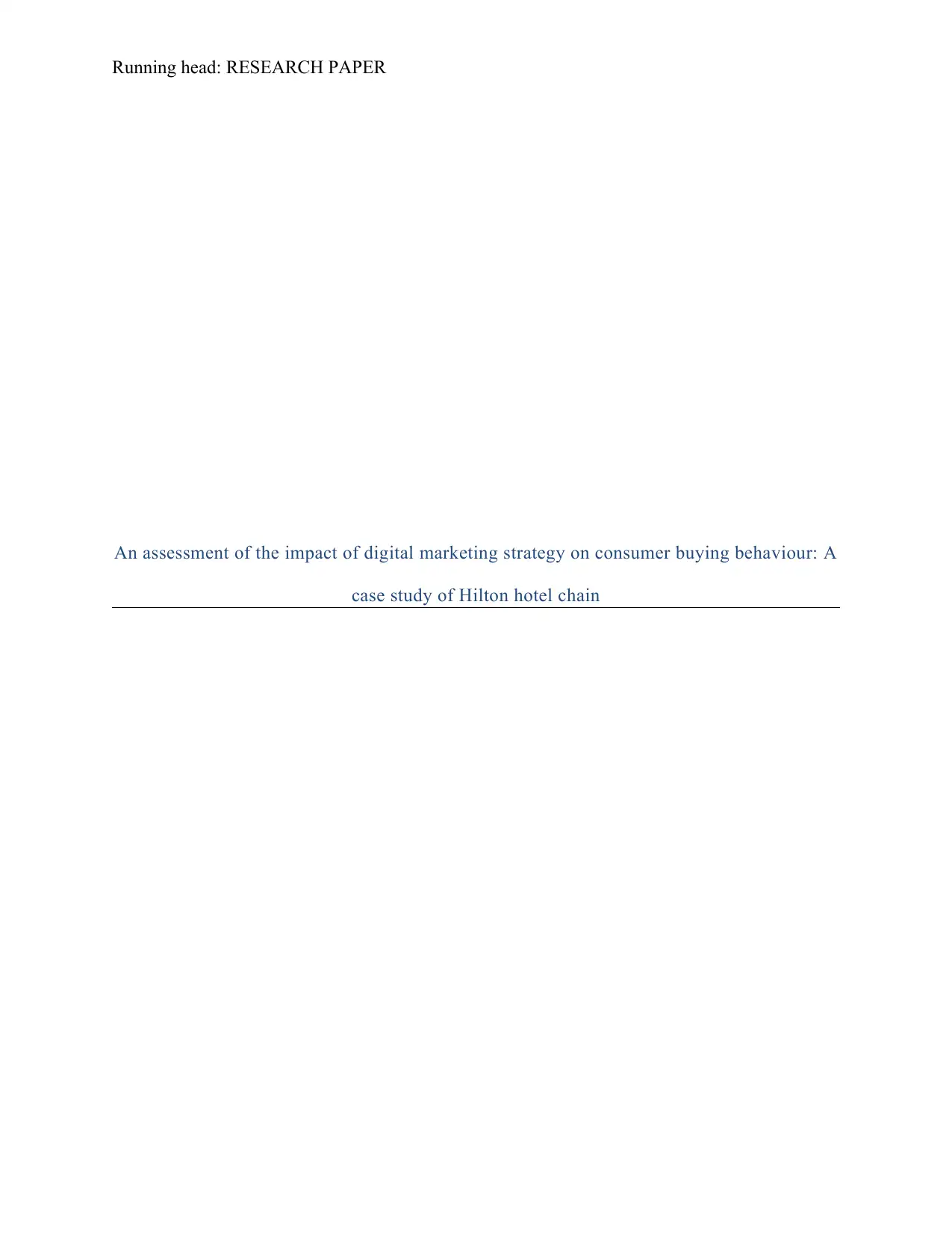
Running head: RESEARCH PAPER
An assessment of the impact of digital marketing strategy on consumer buying behaviour: A
case study of Hilton hotel chain
An assessment of the impact of digital marketing strategy on consumer buying behaviour: A
case study of Hilton hotel chain
Secure Best Marks with AI Grader
Need help grading? Try our AI Grader for instant feedback on your assignments.
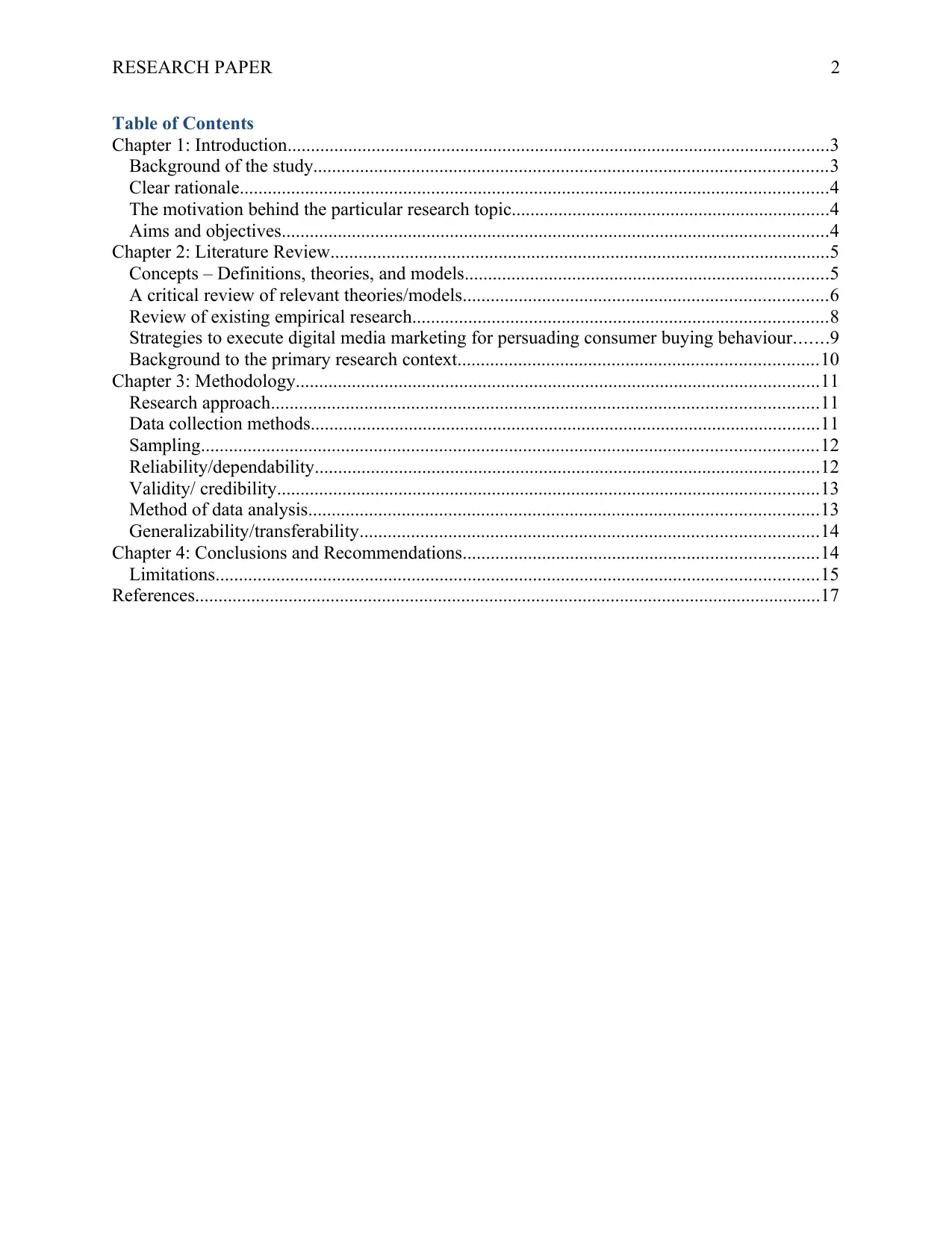
RESEARCH PAPER 2
Table of Contents
Chapter 1: Introduction....................................................................................................................3
Background of the study..............................................................................................................3
Clear rationale..............................................................................................................................4
The motivation behind the particular research topic....................................................................4
Aims and objectives.....................................................................................................................4
Chapter 2: Literature Review...........................................................................................................5
Concepts – Definitions, theories, and models..............................................................................5
A critical review of relevant theories/models..............................................................................6
Review of existing empirical research.........................................................................................8
Strategies to execute digital media marketing for persuading consumer buying behaviour.......9
Background to the primary research context.............................................................................10
Chapter 3: Methodology................................................................................................................11
Research approach.....................................................................................................................11
Data collection methods.............................................................................................................11
Sampling....................................................................................................................................12
Reliability/dependability............................................................................................................12
Validity/ credibility....................................................................................................................13
Method of data analysis.............................................................................................................13
Generalizability/transferability..................................................................................................14
Chapter 4: Conclusions and Recommendations............................................................................14
Limitations.................................................................................................................................15
References......................................................................................................................................17
Table of Contents
Chapter 1: Introduction....................................................................................................................3
Background of the study..............................................................................................................3
Clear rationale..............................................................................................................................4
The motivation behind the particular research topic....................................................................4
Aims and objectives.....................................................................................................................4
Chapter 2: Literature Review...........................................................................................................5
Concepts – Definitions, theories, and models..............................................................................5
A critical review of relevant theories/models..............................................................................6
Review of existing empirical research.........................................................................................8
Strategies to execute digital media marketing for persuading consumer buying behaviour.......9
Background to the primary research context.............................................................................10
Chapter 3: Methodology................................................................................................................11
Research approach.....................................................................................................................11
Data collection methods.............................................................................................................11
Sampling....................................................................................................................................12
Reliability/dependability............................................................................................................12
Validity/ credibility....................................................................................................................13
Method of data analysis.............................................................................................................13
Generalizability/transferability..................................................................................................14
Chapter 4: Conclusions and Recommendations............................................................................14
Limitations.................................................................................................................................15
References......................................................................................................................................17
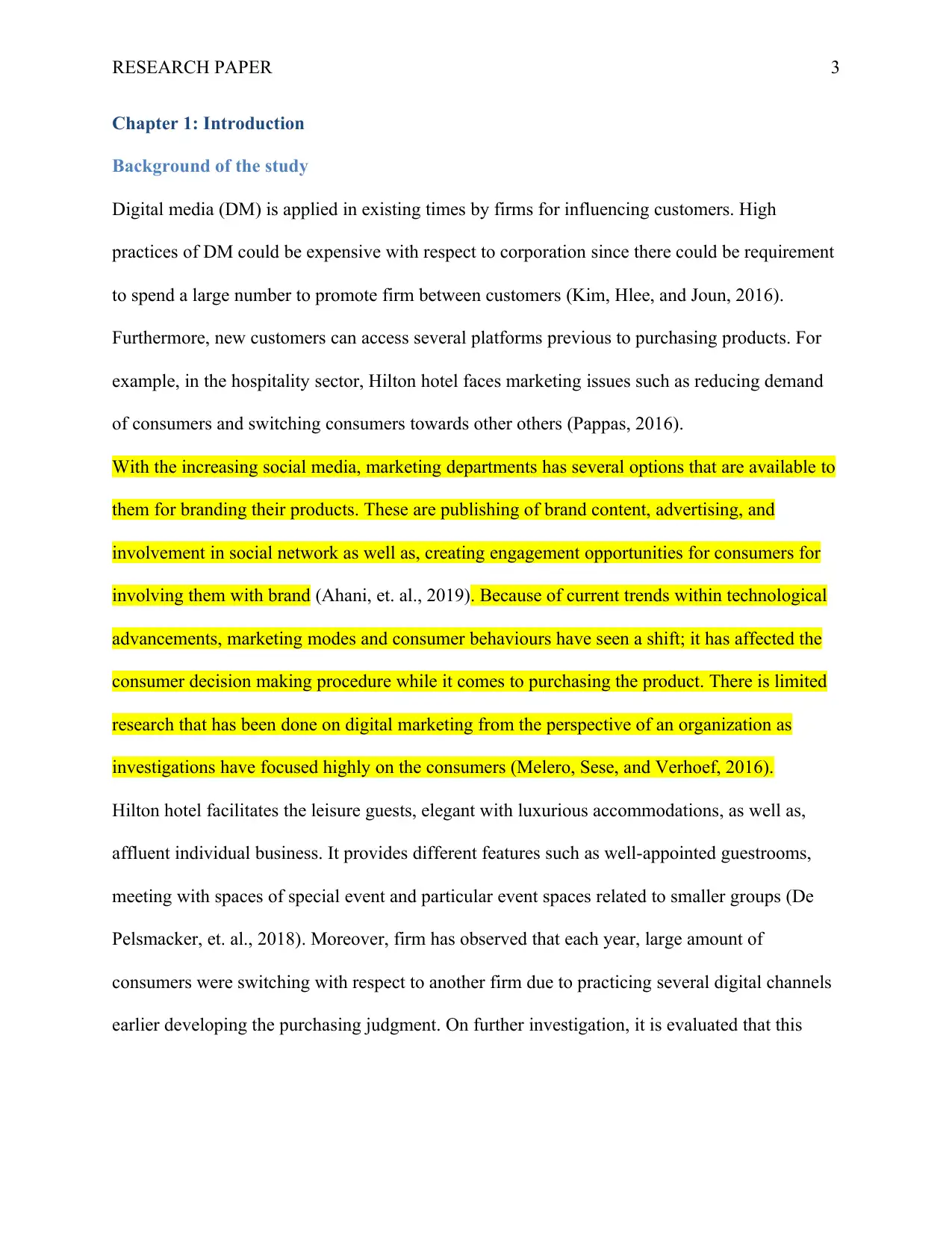
RESEARCH PAPER 3
Chapter 1: Introduction
Background of the study
Digital media (DM) is applied in existing times by firms for influencing customers. High
practices of DM could be expensive with respect to corporation since there could be requirement
to spend a large number to promote firm between customers (Kim, Hlee, and Joun, 2016).
Furthermore, new customers can access several platforms previous to purchasing products. For
example, in the hospitality sector, Hilton hotel faces marketing issues such as reducing demand
of consumers and switching consumers towards other others (Pappas, 2016).
With the increasing social media, marketing departments has several options that are available to
them for branding their products. These are publishing of brand content, advertising, and
involvement in social network as well as, creating engagement opportunities for consumers for
involving them with brand (Ahani, et. al., 2019). Because of current trends within technological
advancements, marketing modes and consumer behaviours have seen a shift; it has affected the
consumer decision making procedure while it comes to purchasing the product. There is limited
research that has been done on digital marketing from the perspective of an organization as
investigations have focused highly on the consumers (Melero, Sese, and Verhoef, 2016).
Hilton hotel facilitates the leisure guests, elegant with luxurious accommodations, as well as,
affluent individual business. It provides different features such as well-appointed guestrooms,
meeting with spaces of special event and particular event spaces related to smaller groups (De
Pelsmacker, et. al., 2018). Moreover, firm has observed that each year, large amount of
consumers were switching with respect to another firm due to practicing several digital channels
earlier developing the purchasing judgment. On further investigation, it is evaluated that this
Chapter 1: Introduction
Background of the study
Digital media (DM) is applied in existing times by firms for influencing customers. High
practices of DM could be expensive with respect to corporation since there could be requirement
to spend a large number to promote firm between customers (Kim, Hlee, and Joun, 2016).
Furthermore, new customers can access several platforms previous to purchasing products. For
example, in the hospitality sector, Hilton hotel faces marketing issues such as reducing demand
of consumers and switching consumers towards other others (Pappas, 2016).
With the increasing social media, marketing departments has several options that are available to
them for branding their products. These are publishing of brand content, advertising, and
involvement in social network as well as, creating engagement opportunities for consumers for
involving them with brand (Ahani, et. al., 2019). Because of current trends within technological
advancements, marketing modes and consumer behaviours have seen a shift; it has affected the
consumer decision making procedure while it comes to purchasing the product. There is limited
research that has been done on digital marketing from the perspective of an organization as
investigations have focused highly on the consumers (Melero, Sese, and Verhoef, 2016).
Hilton hotel facilitates the leisure guests, elegant with luxurious accommodations, as well as,
affluent individual business. It provides different features such as well-appointed guestrooms,
meeting with spaces of special event and particular event spaces related to smaller groups (De
Pelsmacker, et. al., 2018). Moreover, firm has observed that each year, large amount of
consumers were switching with respect to another firm due to practicing several digital channels
earlier developing the purchasing judgment. On further investigation, it is evaluated that this
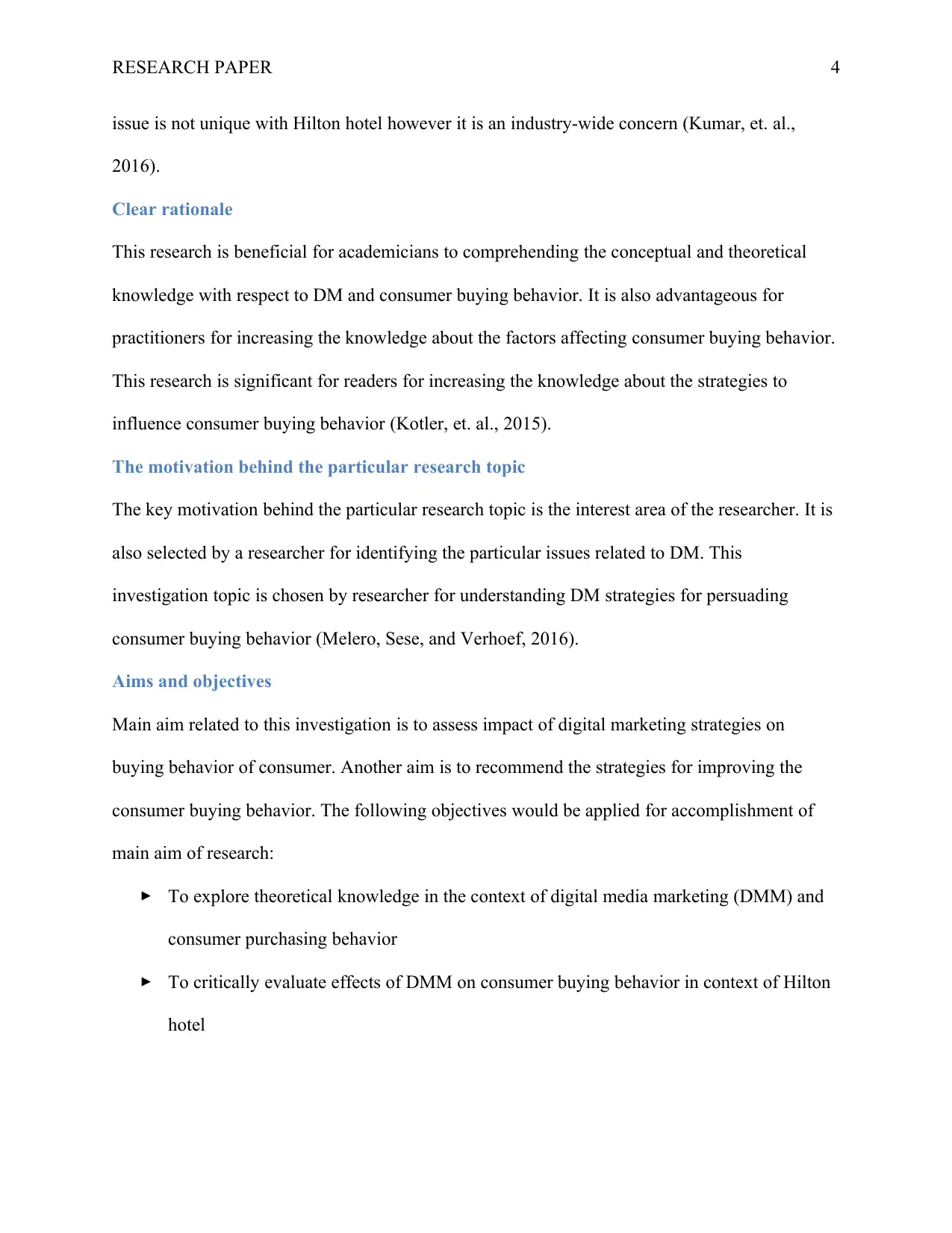
RESEARCH PAPER 4
issue is not unique with Hilton hotel however it is an industry-wide concern (Kumar, et. al.,
2016).
Clear rationale
This research is beneficial for academicians to comprehending the conceptual and theoretical
knowledge with respect to DM and consumer buying behavior. It is also advantageous for
practitioners for increasing the knowledge about the factors affecting consumer buying behavior.
This research is significant for readers for increasing the knowledge about the strategies to
influence consumer buying behavior (Kotler, et. al., 2015).
The motivation behind the particular research topic
The key motivation behind the particular research topic is the interest area of the researcher. It is
also selected by a researcher for identifying the particular issues related to DM. This
investigation topic is chosen by researcher for understanding DM strategies for persuading
consumer buying behavior (Melero, Sese, and Verhoef, 2016).
Aims and objectives
Main aim related to this investigation is to assess impact of digital marketing strategies on
buying behavior of consumer. Another aim is to recommend the strategies for improving the
consumer buying behavior. The following objectives would be applied for accomplishment of
main aim of research:
To explore theoretical knowledge in the context of digital media marketing (DMM) and
consumer purchasing behavior
To critically evaluate effects of DMM on consumer buying behavior in context of Hilton
hotel
issue is not unique with Hilton hotel however it is an industry-wide concern (Kumar, et. al.,
2016).
Clear rationale
This research is beneficial for academicians to comprehending the conceptual and theoretical
knowledge with respect to DM and consumer buying behavior. It is also advantageous for
practitioners for increasing the knowledge about the factors affecting consumer buying behavior.
This research is significant for readers for increasing the knowledge about the strategies to
influence consumer buying behavior (Kotler, et. al., 2015).
The motivation behind the particular research topic
The key motivation behind the particular research topic is the interest area of the researcher. It is
also selected by a researcher for identifying the particular issues related to DM. This
investigation topic is chosen by researcher for understanding DM strategies for persuading
consumer buying behavior (Melero, Sese, and Verhoef, 2016).
Aims and objectives
Main aim related to this investigation is to assess impact of digital marketing strategies on
buying behavior of consumer. Another aim is to recommend the strategies for improving the
consumer buying behavior. The following objectives would be applied for accomplishment of
main aim of research:
To explore theoretical knowledge in the context of digital media marketing (DMM) and
consumer purchasing behavior
To critically evaluate effects of DMM on consumer buying behavior in context of Hilton
hotel
Secure Best Marks with AI Grader
Need help grading? Try our AI Grader for instant feedback on your assignments.
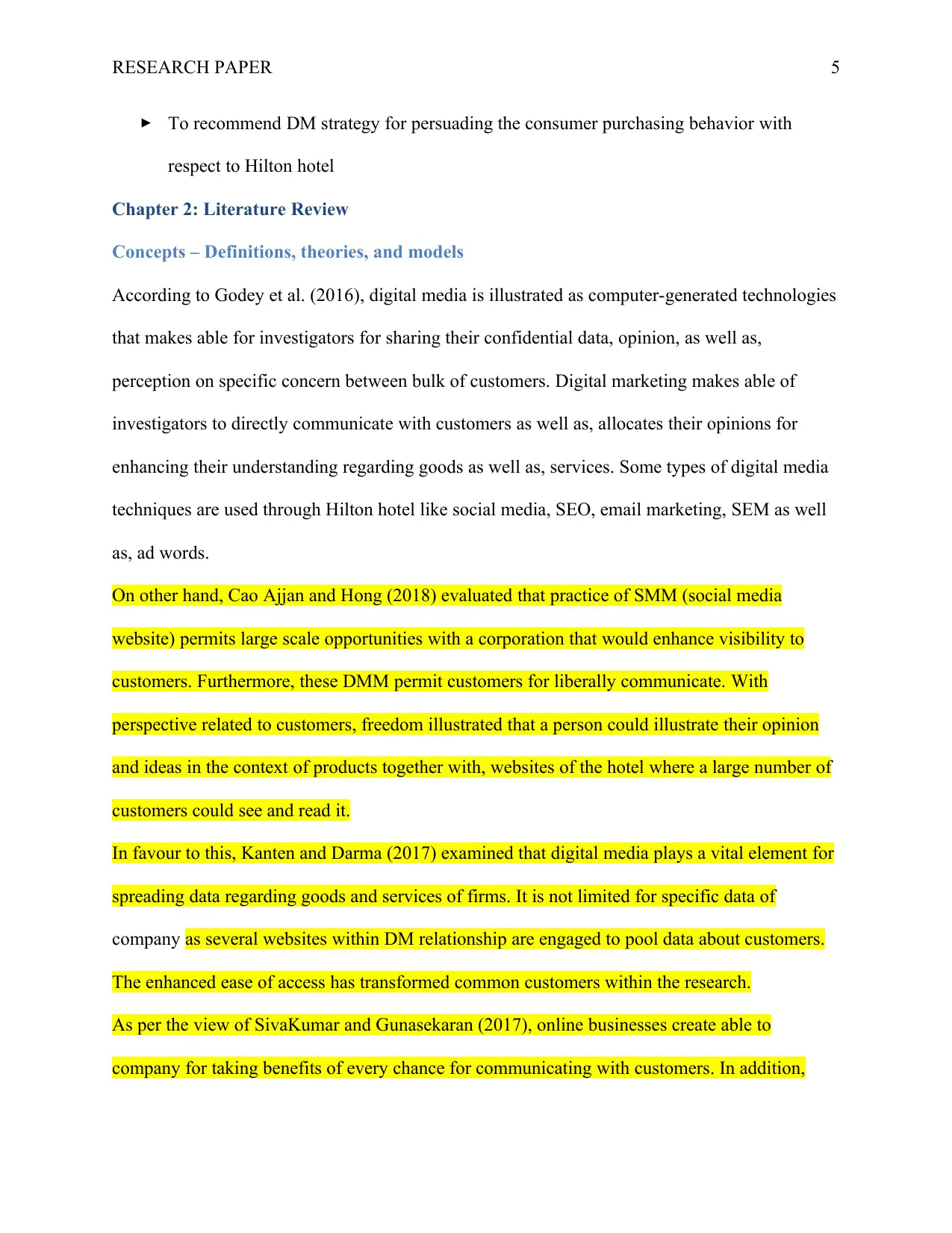
RESEARCH PAPER 5
To recommend DM strategy for persuading the consumer purchasing behavior with
respect to Hilton hotel
Chapter 2: Literature Review
Concepts – Definitions, theories, and models
According to Godey et al. (2016), digital media is illustrated as computer-generated technologies
that makes able for investigators for sharing their confidential data, opinion, as well as,
perception on specific concern between bulk of customers. Digital marketing makes able of
investigators to directly communicate with customers as well as, allocates their opinions for
enhancing their understanding regarding goods as well as, services. Some types of digital media
techniques are used through Hilton hotel like social media, SEO, email marketing, SEM as well
as, ad words.
On other hand, Cao Ajjan and Hong (2018) evaluated that practice of SMM (social media
website) permits large scale opportunities with a corporation that would enhance visibility to
customers. Furthermore, these DMM permit customers for liberally communicate. With
perspective related to customers, freedom illustrated that a person could illustrate their opinion
and ideas in the context of products together with, websites of the hotel where a large number of
customers could see and read it.
In favour to this, Kanten and Darma (2017) examined that digital media plays a vital element for
spreading data regarding goods and services of firms. It is not limited for specific data of
company as several websites within DM relationship are engaged to pool data about customers.
The enhanced ease of access has transformed common customers within the research.
As per the view of SivaKumar and Gunasekaran (2017), online businesses create able to
company for taking benefits of every chance for communicating with customers. In addition,
To recommend DM strategy for persuading the consumer purchasing behavior with
respect to Hilton hotel
Chapter 2: Literature Review
Concepts – Definitions, theories, and models
According to Godey et al. (2016), digital media is illustrated as computer-generated technologies
that makes able for investigators for sharing their confidential data, opinion, as well as,
perception on specific concern between bulk of customers. Digital marketing makes able of
investigators to directly communicate with customers as well as, allocates their opinions for
enhancing their understanding regarding goods as well as, services. Some types of digital media
techniques are used through Hilton hotel like social media, SEO, email marketing, SEM as well
as, ad words.
On other hand, Cao Ajjan and Hong (2018) evaluated that practice of SMM (social media
website) permits large scale opportunities with a corporation that would enhance visibility to
customers. Furthermore, these DMM permit customers for liberally communicate. With
perspective related to customers, freedom illustrated that a person could illustrate their opinion
and ideas in the context of products together with, websites of the hotel where a large number of
customers could see and read it.
In favour to this, Kanten and Darma (2017) examined that digital media plays a vital element for
spreading data regarding goods and services of firms. It is not limited for specific data of
company as several websites within DM relationship are engaged to pool data about customers.
The enhanced ease of access has transformed common customers within the research.
As per the view of SivaKumar and Gunasekaran (2017), online businesses create able to
company for taking benefits of every chance for communicating with customers. In addition,
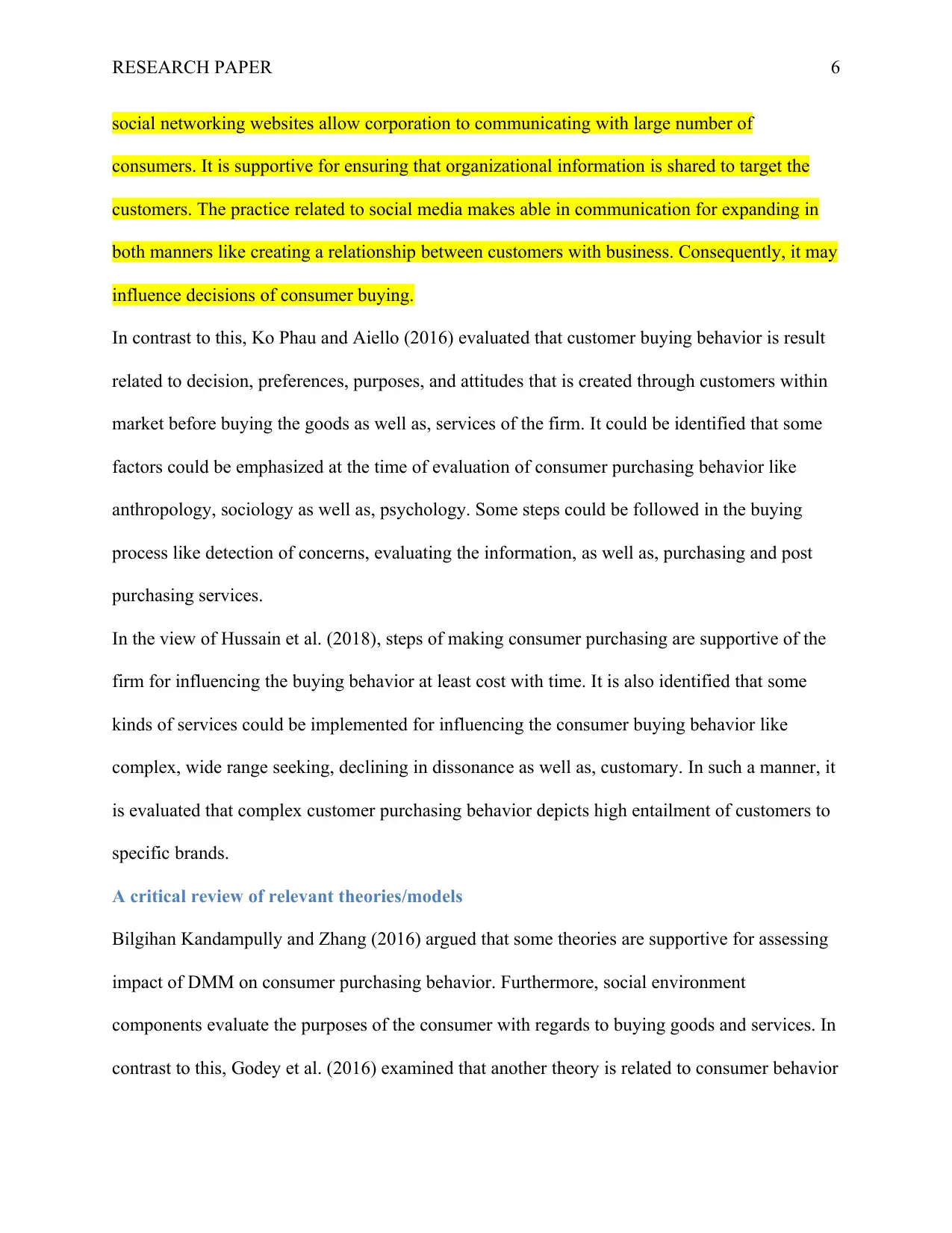
RESEARCH PAPER 6
social networking websites allow corporation to communicating with large number of
consumers. It is supportive for ensuring that organizational information is shared to target the
customers. The practice related to social media makes able in communication for expanding in
both manners like creating a relationship between customers with business. Consequently, it may
influence decisions of consumer buying.
In contrast to this, Ko Phau and Aiello (2016) evaluated that customer buying behavior is result
related to decision, preferences, purposes, and attitudes that is created through customers within
market before buying the goods as well as, services of the firm. It could be identified that some
factors could be emphasized at the time of evaluation of consumer purchasing behavior like
anthropology, sociology as well as, psychology. Some steps could be followed in the buying
process like detection of concerns, evaluating the information, as well as, purchasing and post
purchasing services.
In the view of Hussain et al. (2018), steps of making consumer purchasing are supportive of the
firm for influencing the buying behavior at least cost with time. It is also identified that some
kinds of services could be implemented for influencing the consumer buying behavior like
complex, wide range seeking, declining in dissonance as well as, customary. In such a manner, it
is evaluated that complex customer purchasing behavior depicts high entailment of customers to
specific brands.
A critical review of relevant theories/models
Bilgihan Kandampully and Zhang (2016) argued that some theories are supportive for assessing
impact of DMM on consumer purchasing behavior. Furthermore, social environment
components evaluate the purposes of the consumer with regards to buying goods and services. In
contrast to this, Godey et al. (2016) examined that another theory is related to consumer behavior
social networking websites allow corporation to communicating with large number of
consumers. It is supportive for ensuring that organizational information is shared to target the
customers. The practice related to social media makes able in communication for expanding in
both manners like creating a relationship between customers with business. Consequently, it may
influence decisions of consumer buying.
In contrast to this, Ko Phau and Aiello (2016) evaluated that customer buying behavior is result
related to decision, preferences, purposes, and attitudes that is created through customers within
market before buying the goods as well as, services of the firm. It could be identified that some
factors could be emphasized at the time of evaluation of consumer purchasing behavior like
anthropology, sociology as well as, psychology. Some steps could be followed in the buying
process like detection of concerns, evaluating the information, as well as, purchasing and post
purchasing services.
In the view of Hussain et al. (2018), steps of making consumer purchasing are supportive of the
firm for influencing the buying behavior at least cost with time. It is also identified that some
kinds of services could be implemented for influencing the consumer buying behavior like
complex, wide range seeking, declining in dissonance as well as, customary. In such a manner, it
is evaluated that complex customer purchasing behavior depicts high entailment of customers to
specific brands.
A critical review of relevant theories/models
Bilgihan Kandampully and Zhang (2016) argued that some theories are supportive for assessing
impact of DMM on consumer purchasing behavior. Furthermore, social environment
components evaluate the purposes of the consumer with regards to buying goods and services. In
contrast to this, Godey et al. (2016) examined that another theory is related to consumer behavior
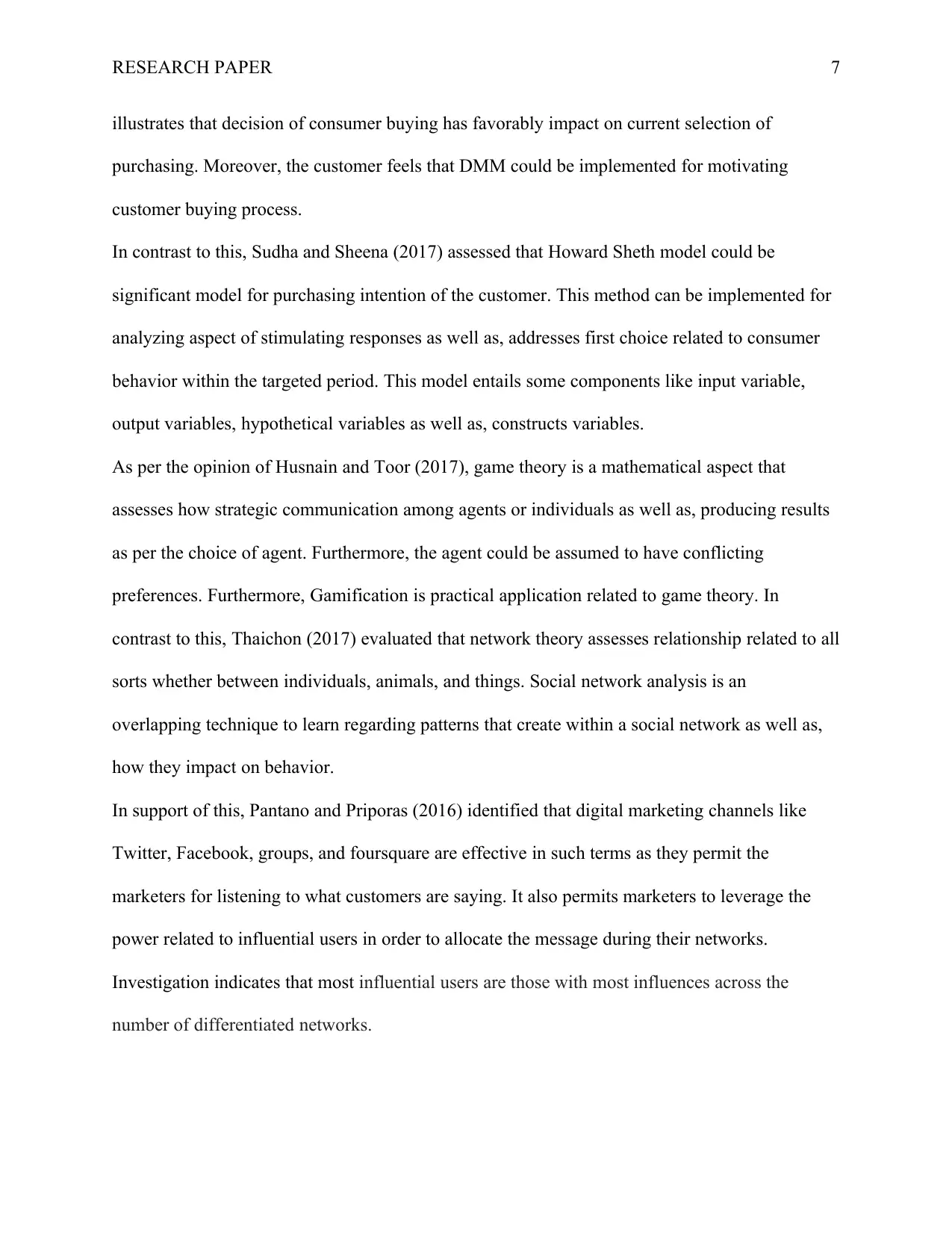
RESEARCH PAPER 7
illustrates that decision of consumer buying has favorably impact on current selection of
purchasing. Moreover, the customer feels that DMM could be implemented for motivating
customer buying process.
In contrast to this, Sudha and Sheena (2017) assessed that Howard Sheth model could be
significant model for purchasing intention of the customer. This method can be implemented for
analyzing aspect of stimulating responses as well as, addresses first choice related to consumer
behavior within the targeted period. This model entails some components like input variable,
output variables, hypothetical variables as well as, constructs variables.
As per the opinion of Husnain and Toor (2017), game theory is a mathematical aspect that
assesses how strategic communication among agents or individuals as well as, producing results
as per the choice of agent. Furthermore, the agent could be assumed to have conflicting
preferences. Furthermore, Gamification is practical application related to game theory. In
contrast to this, Thaichon (2017) evaluated that network theory assesses relationship related to all
sorts whether between individuals, animals, and things. Social network analysis is an
overlapping technique to learn regarding patterns that create within a social network as well as,
how they impact on behavior.
In support of this, Pantano and Priporas (2016) identified that digital marketing channels like
Twitter, Facebook, groups, and foursquare are effective in such terms as they permit the
marketers for listening to what customers are saying. It also permits marketers to leverage the
power related to influential users in order to allocate the message during their networks.
Investigation indicates that most influential users are those with most influences across the
number of differentiated networks.
illustrates that decision of consumer buying has favorably impact on current selection of
purchasing. Moreover, the customer feels that DMM could be implemented for motivating
customer buying process.
In contrast to this, Sudha and Sheena (2017) assessed that Howard Sheth model could be
significant model for purchasing intention of the customer. This method can be implemented for
analyzing aspect of stimulating responses as well as, addresses first choice related to consumer
behavior within the targeted period. This model entails some components like input variable,
output variables, hypothetical variables as well as, constructs variables.
As per the opinion of Husnain and Toor (2017), game theory is a mathematical aspect that
assesses how strategic communication among agents or individuals as well as, producing results
as per the choice of agent. Furthermore, the agent could be assumed to have conflicting
preferences. Furthermore, Gamification is practical application related to game theory. In
contrast to this, Thaichon (2017) evaluated that network theory assesses relationship related to all
sorts whether between individuals, animals, and things. Social network analysis is an
overlapping technique to learn regarding patterns that create within a social network as well as,
how they impact on behavior.
In support of this, Pantano and Priporas (2016) identified that digital marketing channels like
Twitter, Facebook, groups, and foursquare are effective in such terms as they permit the
marketers for listening to what customers are saying. It also permits marketers to leverage the
power related to influential users in order to allocate the message during their networks.
Investigation indicates that most influential users are those with most influences across the
number of differentiated networks.
Paraphrase This Document
Need a fresh take? Get an instant paraphrase of this document with our AI Paraphraser
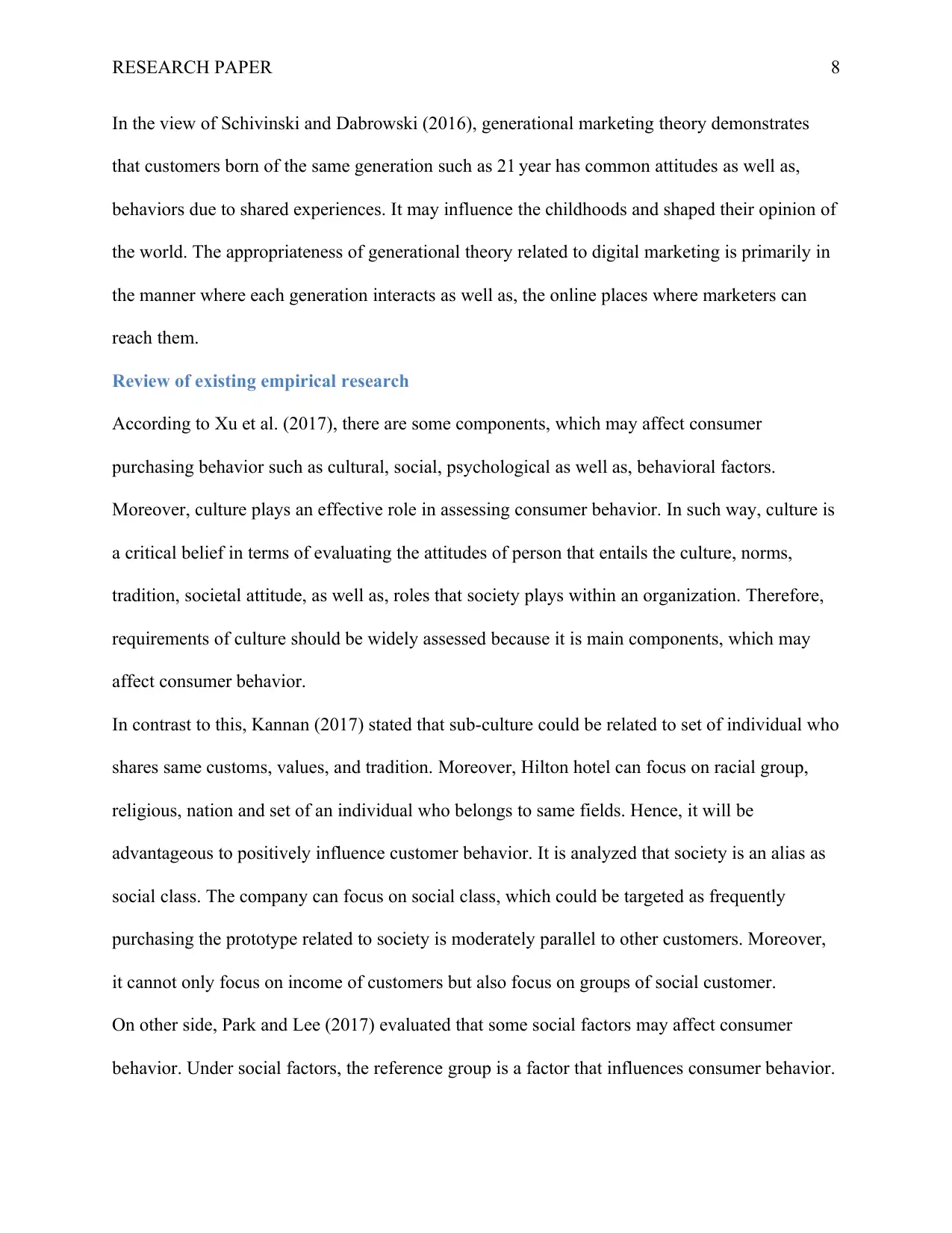
RESEARCH PAPER 8
In the view of Schivinski and Dabrowski (2016), generational marketing theory demonstrates
that customers born of the same generation such as 21 year has common attitudes as well as,
behaviors due to shared experiences. It may influence the childhoods and shaped their opinion of
the world. The appropriateness of generational theory related to digital marketing is primarily in
the manner where each generation interacts as well as, the online places where marketers can
reach them.
Review of existing empirical research
According to Xu et al. (2017), there are some components, which may affect consumer
purchasing behavior such as cultural, social, psychological as well as, behavioral factors.
Moreover, culture plays an effective role in assessing consumer behavior. In such way, culture is
a critical belief in terms of evaluating the attitudes of person that entails the culture, norms,
tradition, societal attitude, as well as, roles that society plays within an organization. Therefore,
requirements of culture should be widely assessed because it is main components, which may
affect consumer behavior.
In contrast to this, Kannan (2017) stated that sub-culture could be related to set of individual who
shares same customs, values, and tradition. Moreover, Hilton hotel can focus on racial group,
religious, nation and set of an individual who belongs to same fields. Hence, it will be
advantageous to positively influence customer behavior. It is analyzed that society is an alias as
social class. The company can focus on social class, which could be targeted as frequently
purchasing the prototype related to society is moderately parallel to other customers. Moreover,
it cannot only focus on income of customers but also focus on groups of social customer.
On other side, Park and Lee (2017) evaluated that some social factors may affect consumer
behavior. Under social factors, the reference group is a factor that influences consumer behavior.
In the view of Schivinski and Dabrowski (2016), generational marketing theory demonstrates
that customers born of the same generation such as 21 year has common attitudes as well as,
behaviors due to shared experiences. It may influence the childhoods and shaped their opinion of
the world. The appropriateness of generational theory related to digital marketing is primarily in
the manner where each generation interacts as well as, the online places where marketers can
reach them.
Review of existing empirical research
According to Xu et al. (2017), there are some components, which may affect consumer
purchasing behavior such as cultural, social, psychological as well as, behavioral factors.
Moreover, culture plays an effective role in assessing consumer behavior. In such way, culture is
a critical belief in terms of evaluating the attitudes of person that entails the culture, norms,
tradition, societal attitude, as well as, roles that society plays within an organization. Therefore,
requirements of culture should be widely assessed because it is main components, which may
affect consumer behavior.
In contrast to this, Kannan (2017) stated that sub-culture could be related to set of individual who
shares same customs, values, and tradition. Moreover, Hilton hotel can focus on racial group,
religious, nation and set of an individual who belongs to same fields. Hence, it will be
advantageous to positively influence customer behavior. It is analyzed that society is an alias as
social class. The company can focus on social class, which could be targeted as frequently
purchasing the prototype related to society is moderately parallel to other customers. Moreover,
it cannot only focus on income of customers but also focus on groups of social customer.
On other side, Park and Lee (2017) evaluated that some social factors may affect consumer
behavior. Under social factors, the reference group is a factor that influences consumer behavior.
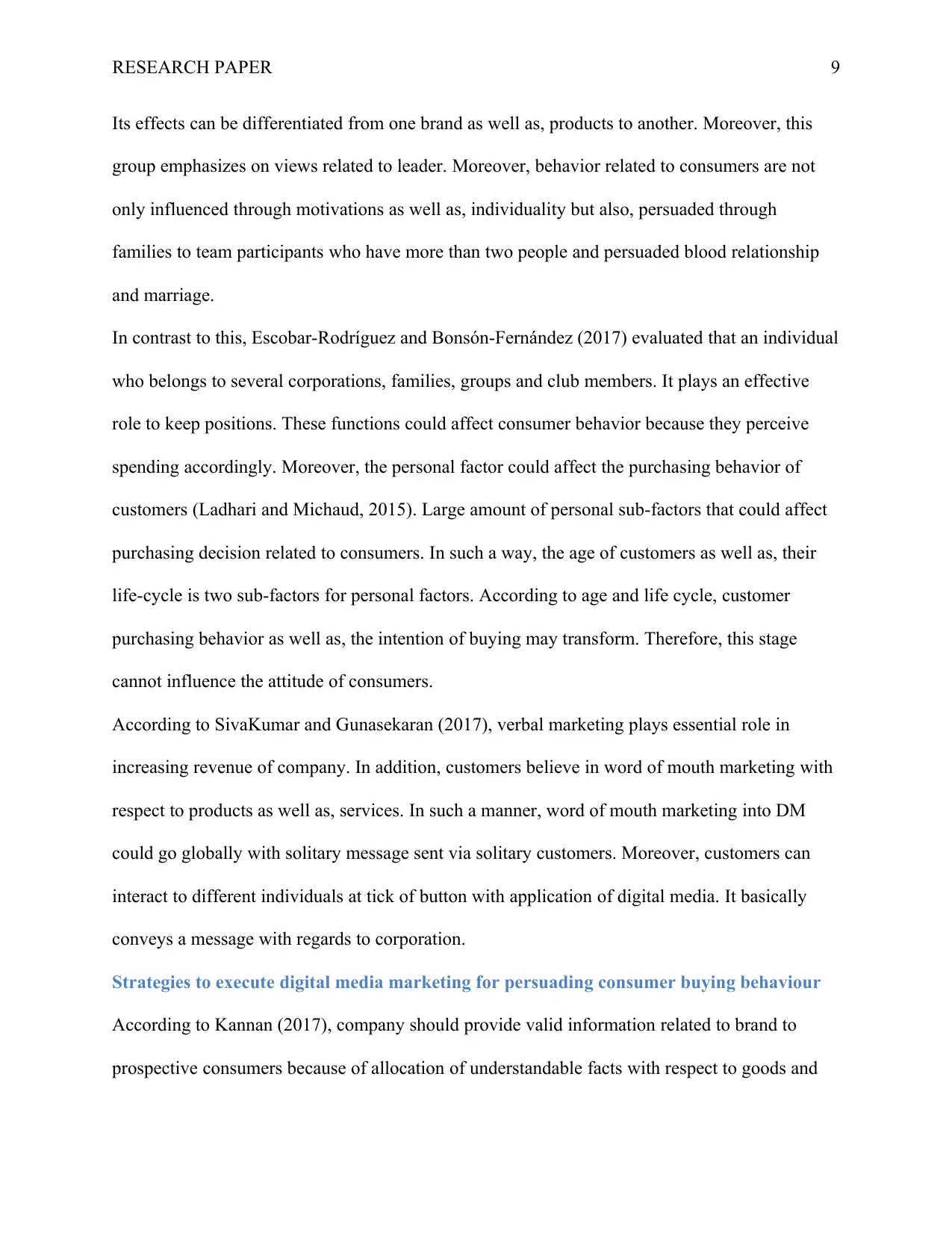
RESEARCH PAPER 9
Its effects can be differentiated from one brand as well as, products to another. Moreover, this
group emphasizes on views related to leader. Moreover, behavior related to consumers are not
only influenced through motivations as well as, individuality but also, persuaded through
families to team participants who have more than two people and persuaded blood relationship
and marriage.
In contrast to this, Escobar-Rodríguez and Bonsón-Fernández (2017) evaluated that an individual
who belongs to several corporations, families, groups and club members. It plays an effective
role to keep positions. These functions could affect consumer behavior because they perceive
spending accordingly. Moreover, the personal factor could affect the purchasing behavior of
customers (Ladhari and Michaud, 2015). Large amount of personal sub-factors that could affect
purchasing decision related to consumers. In such a way, the age of customers as well as, their
life-cycle is two sub-factors for personal factors. According to age and life cycle, customer
purchasing behavior as well as, the intention of buying may transform. Therefore, this stage
cannot influence the attitude of consumers.
According to SivaKumar and Gunasekaran (2017), verbal marketing plays essential role in
increasing revenue of company. In addition, customers believe in word of mouth marketing with
respect to products as well as, services. In such a manner, word of mouth marketing into DM
could go globally with solitary message sent via solitary customers. Moreover, customers can
interact to different individuals at tick of button with application of digital media. It basically
conveys a message with regards to corporation.
Strategies to execute digital media marketing for persuading consumer buying behaviour
According to Kannan (2017), company should provide valid information related to brand to
prospective consumers because of allocation of understandable facts with respect to goods and
Its effects can be differentiated from one brand as well as, products to another. Moreover, this
group emphasizes on views related to leader. Moreover, behavior related to consumers are not
only influenced through motivations as well as, individuality but also, persuaded through
families to team participants who have more than two people and persuaded blood relationship
and marriage.
In contrast to this, Escobar-Rodríguez and Bonsón-Fernández (2017) evaluated that an individual
who belongs to several corporations, families, groups and club members. It plays an effective
role to keep positions. These functions could affect consumer behavior because they perceive
spending accordingly. Moreover, the personal factor could affect the purchasing behavior of
customers (Ladhari and Michaud, 2015). Large amount of personal sub-factors that could affect
purchasing decision related to consumers. In such a way, the age of customers as well as, their
life-cycle is two sub-factors for personal factors. According to age and life cycle, customer
purchasing behavior as well as, the intention of buying may transform. Therefore, this stage
cannot influence the attitude of consumers.
According to SivaKumar and Gunasekaran (2017), verbal marketing plays essential role in
increasing revenue of company. In addition, customers believe in word of mouth marketing with
respect to products as well as, services. In such a manner, word of mouth marketing into DM
could go globally with solitary message sent via solitary customers. Moreover, customers can
interact to different individuals at tick of button with application of digital media. It basically
conveys a message with regards to corporation.
Strategies to execute digital media marketing for persuading consumer buying behaviour
According to Kannan (2017), company should provide valid information related to brand to
prospective consumers because of allocation of understandable facts with respect to goods and
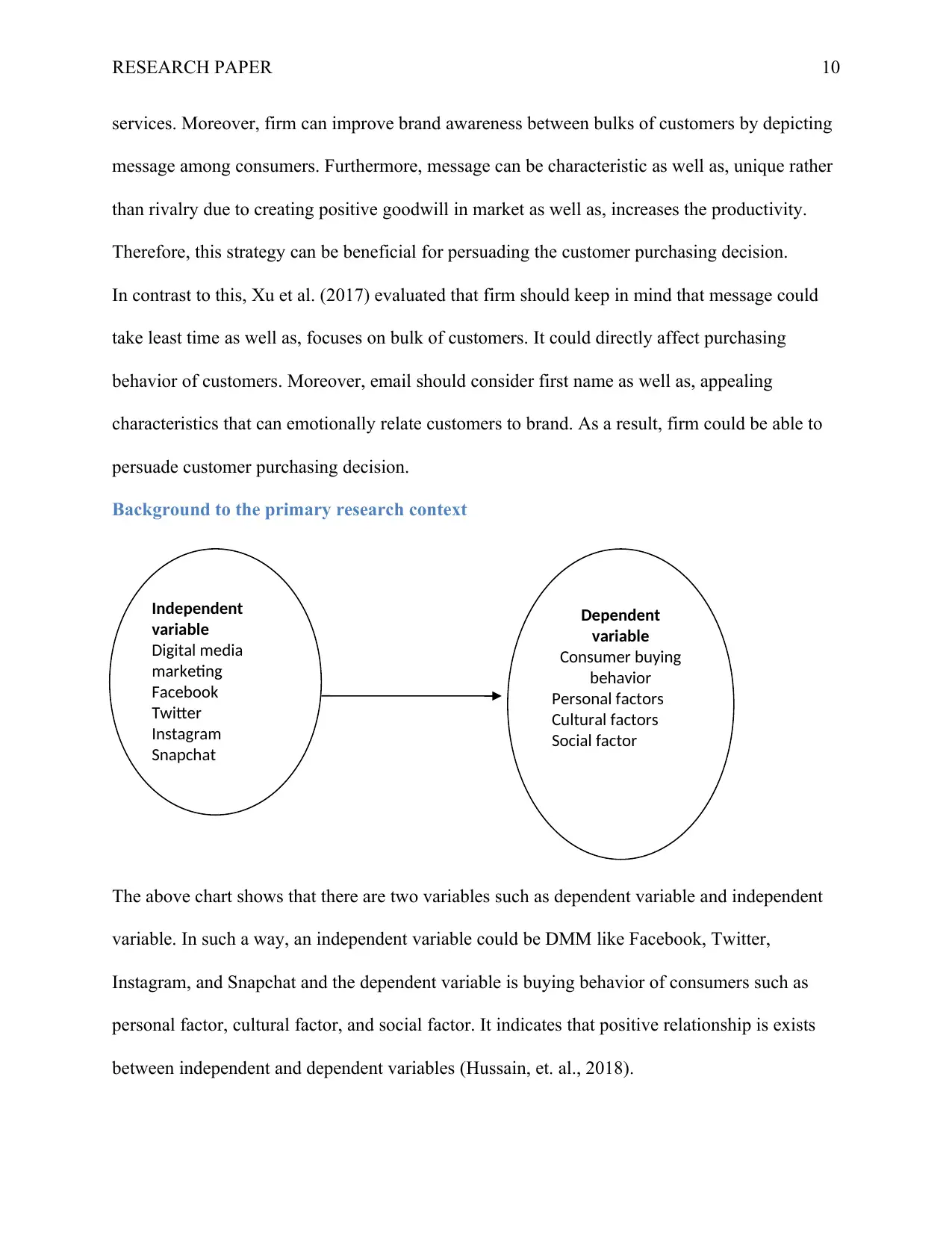
RESEARCH PAPER 10
services. Moreover, firm can improve brand awareness between bulks of customers by depicting
message among consumers. Furthermore, message can be characteristic as well as, unique rather
than rivalry due to creating positive goodwill in market as well as, increases the productivity.
Therefore, this strategy can be beneficial for persuading the customer purchasing decision.
In contrast to this, Xu et al. (2017) evaluated that firm should keep in mind that message could
take least time as well as, focuses on bulk of customers. It could directly affect purchasing
behavior of customers. Moreover, email should consider first name as well as, appealing
characteristics that can emotionally relate customers to brand. As a result, firm could be able to
persuade customer purchasing decision.
Background to the primary research context
The above chart shows that there are two variables such as dependent variable and independent
variable. In such a way, an independent variable could be DMM like Facebook, Twitter,
Instagram, and Snapchat and the dependent variable is buying behavior of consumers such as
personal factor, cultural factor, and social factor. It indicates that positive relationship is exists
between independent and dependent variables (Hussain, et. al., 2018).
Independent
variable
Digital media
marketing
Facebook
Twitter
Instagram
Snapchat
Dependent
variable
Consumer buying
behavior
Personal factors
Cultural factors
Social factor
services. Moreover, firm can improve brand awareness between bulks of customers by depicting
message among consumers. Furthermore, message can be characteristic as well as, unique rather
than rivalry due to creating positive goodwill in market as well as, increases the productivity.
Therefore, this strategy can be beneficial for persuading the customer purchasing decision.
In contrast to this, Xu et al. (2017) evaluated that firm should keep in mind that message could
take least time as well as, focuses on bulk of customers. It could directly affect purchasing
behavior of customers. Moreover, email should consider first name as well as, appealing
characteristics that can emotionally relate customers to brand. As a result, firm could be able to
persuade customer purchasing decision.
Background to the primary research context
The above chart shows that there are two variables such as dependent variable and independent
variable. In such a way, an independent variable could be DMM like Facebook, Twitter,
Instagram, and Snapchat and the dependent variable is buying behavior of consumers such as
personal factor, cultural factor, and social factor. It indicates that positive relationship is exists
between independent and dependent variables (Hussain, et. al., 2018).
Independent
variable
Digital media
marketing
Snapchat
Dependent
variable
Consumer buying
behavior
Personal factors
Cultural factors
Social factor
Secure Best Marks with AI Grader
Need help grading? Try our AI Grader for instant feedback on your assignments.
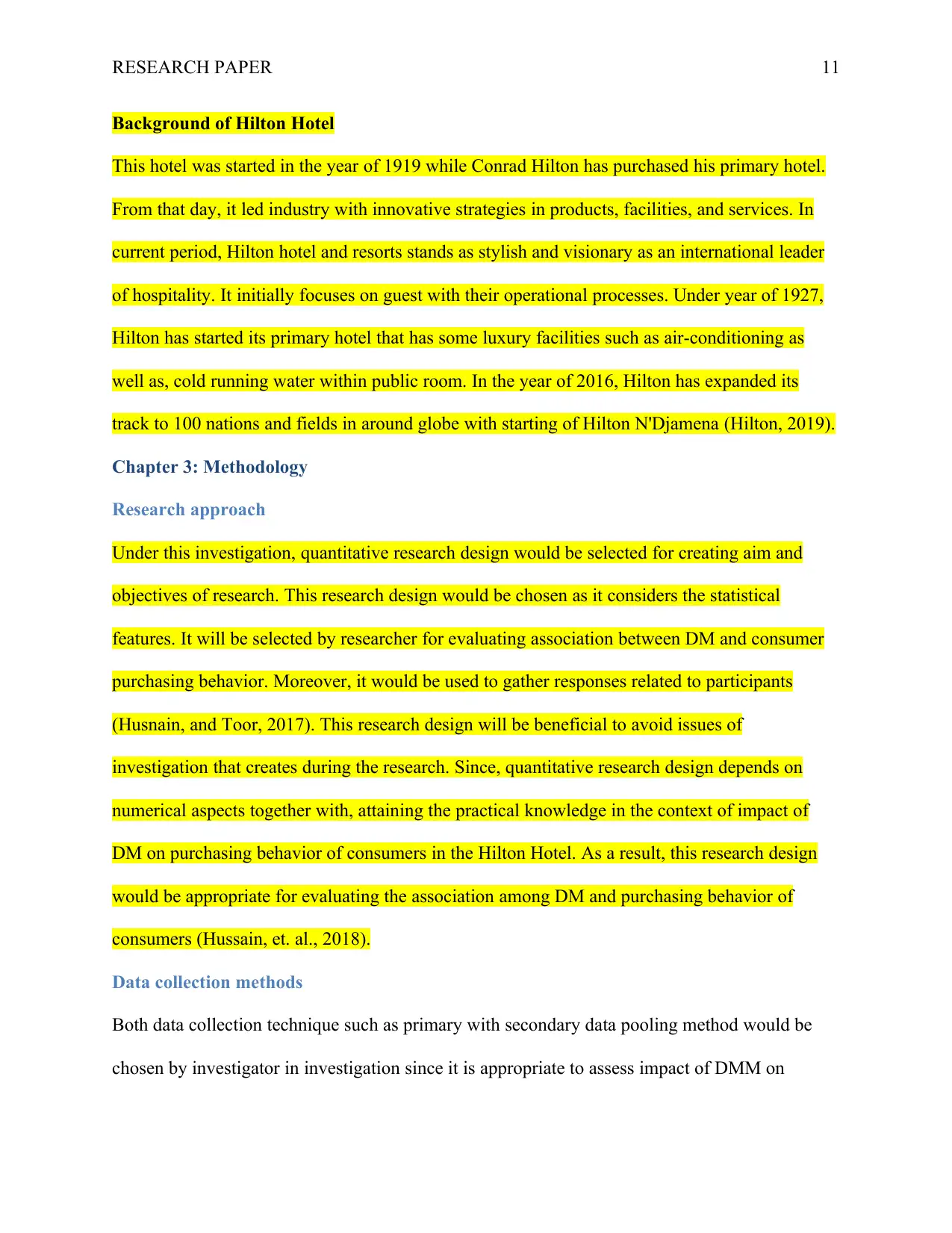
RESEARCH PAPER 11
Background of Hilton Hotel
This hotel was started in the year of 1919 while Conrad Hilton has purchased his primary hotel.
From that day, it led industry with innovative strategies in products, facilities, and services. In
current period, Hilton hotel and resorts stands as stylish and visionary as an international leader
of hospitality. It initially focuses on guest with their operational processes. Under year of 1927,
Hilton has started its primary hotel that has some luxury facilities such as air-conditioning as
well as, cold running water within public room. In the year of 2016, Hilton has expanded its
track to 100 nations and fields in around globe with starting of Hilton N'Djamena (Hilton, 2019).
Chapter 3: Methodology
Research approach
Under this investigation, quantitative research design would be selected for creating aim and
objectives of research. This research design would be chosen as it considers the statistical
features. It will be selected by researcher for evaluating association between DM and consumer
purchasing behavior. Moreover, it would be used to gather responses related to participants
(Husnain, and Toor, 2017). This research design will be beneficial to avoid issues of
investigation that creates during the research. Since, quantitative research design depends on
numerical aspects together with, attaining the practical knowledge in the context of impact of
DM on purchasing behavior of consumers in the Hilton Hotel. As a result, this research design
would be appropriate for evaluating the association among DM and purchasing behavior of
consumers (Hussain, et. al., 2018).
Data collection methods
Both data collection technique such as primary with secondary data pooling method would be
chosen by investigator in investigation since it is appropriate to assess impact of DMM on
Background of Hilton Hotel
This hotel was started in the year of 1919 while Conrad Hilton has purchased his primary hotel.
From that day, it led industry with innovative strategies in products, facilities, and services. In
current period, Hilton hotel and resorts stands as stylish and visionary as an international leader
of hospitality. It initially focuses on guest with their operational processes. Under year of 1927,
Hilton has started its primary hotel that has some luxury facilities such as air-conditioning as
well as, cold running water within public room. In the year of 2016, Hilton has expanded its
track to 100 nations and fields in around globe with starting of Hilton N'Djamena (Hilton, 2019).
Chapter 3: Methodology
Research approach
Under this investigation, quantitative research design would be selected for creating aim and
objectives of research. This research design would be chosen as it considers the statistical
features. It will be selected by researcher for evaluating association between DM and consumer
purchasing behavior. Moreover, it would be used to gather responses related to participants
(Husnain, and Toor, 2017). This research design will be beneficial to avoid issues of
investigation that creates during the research. Since, quantitative research design depends on
numerical aspects together with, attaining the practical knowledge in the context of impact of
DM on purchasing behavior of consumers in the Hilton Hotel. As a result, this research design
would be appropriate for evaluating the association among DM and purchasing behavior of
consumers (Hussain, et. al., 2018).
Data collection methods
Both data collection technique such as primary with secondary data pooling method would be
chosen by investigator in investigation since it is appropriate to assess impact of DMM on
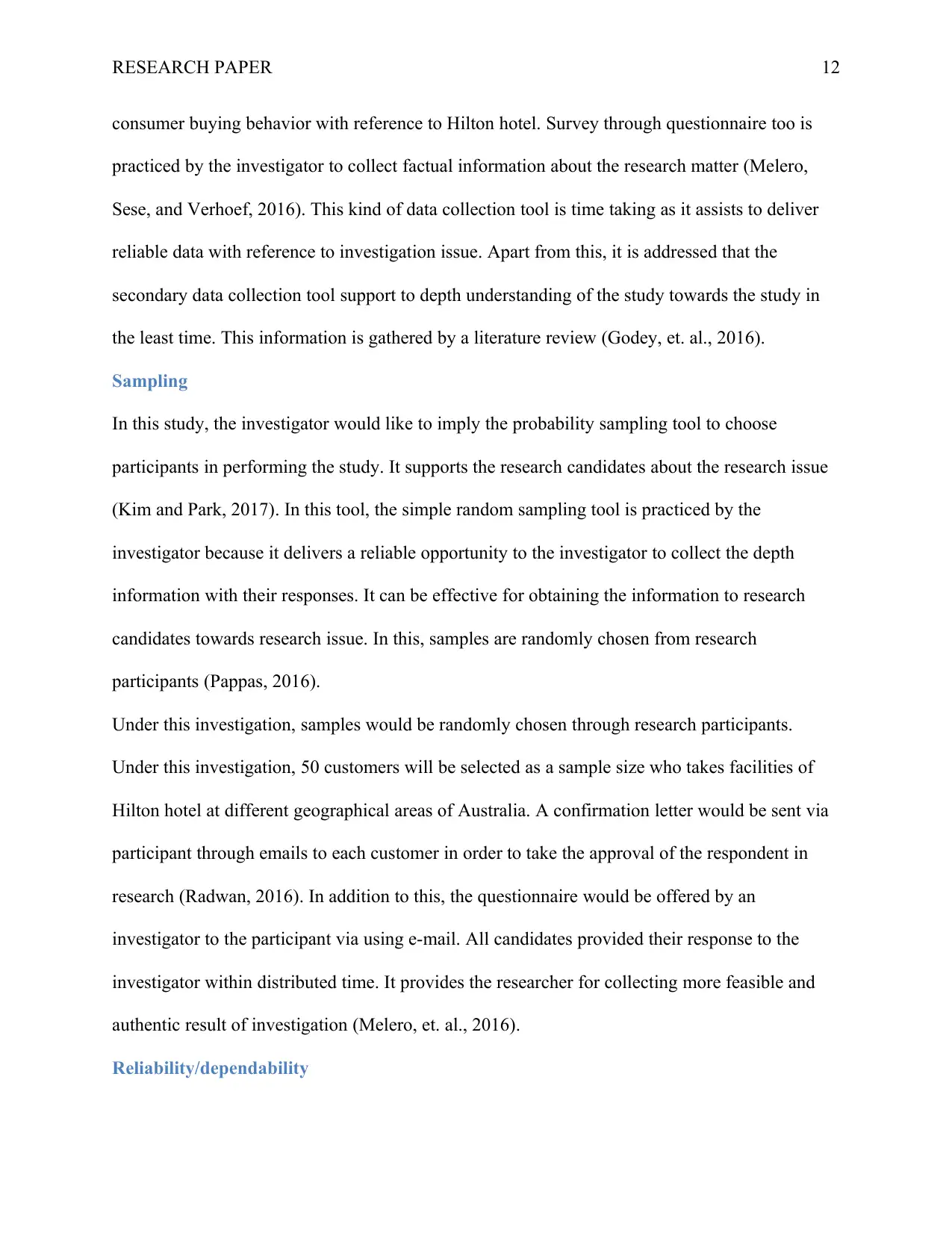
RESEARCH PAPER 12
consumer buying behavior with reference to Hilton hotel. Survey through questionnaire too is
practiced by the investigator to collect factual information about the research matter (Melero,
Sese, and Verhoef, 2016). This kind of data collection tool is time taking as it assists to deliver
reliable data with reference to investigation issue. Apart from this, it is addressed that the
secondary data collection tool support to depth understanding of the study towards the study in
the least time. This information is gathered by a literature review (Godey, et. al., 2016).
Sampling
In this study, the investigator would like to imply the probability sampling tool to choose
participants in performing the study. It supports the research candidates about the research issue
(Kim and Park, 2017). In this tool, the simple random sampling tool is practiced by the
investigator because it delivers a reliable opportunity to the investigator to collect the depth
information with their responses. It can be effective for obtaining the information to research
candidates towards research issue. In this, samples are randomly chosen from research
participants (Pappas, 2016).
Under this investigation, samples would be randomly chosen through research participants.
Under this investigation, 50 customers will be selected as a sample size who takes facilities of
Hilton hotel at different geographical areas of Australia. A confirmation letter would be sent via
participant through emails to each customer in order to take the approval of the respondent in
research (Radwan, 2016). In addition to this, the questionnaire would be offered by an
investigator to the participant via using e-mail. All candidates provided their response to the
investigator within distributed time. It provides the researcher for collecting more feasible and
authentic result of investigation (Melero, et. al., 2016).
Reliability/dependability
consumer buying behavior with reference to Hilton hotel. Survey through questionnaire too is
practiced by the investigator to collect factual information about the research matter (Melero,
Sese, and Verhoef, 2016). This kind of data collection tool is time taking as it assists to deliver
reliable data with reference to investigation issue. Apart from this, it is addressed that the
secondary data collection tool support to depth understanding of the study towards the study in
the least time. This information is gathered by a literature review (Godey, et. al., 2016).
Sampling
In this study, the investigator would like to imply the probability sampling tool to choose
participants in performing the study. It supports the research candidates about the research issue
(Kim and Park, 2017). In this tool, the simple random sampling tool is practiced by the
investigator because it delivers a reliable opportunity to the investigator to collect the depth
information with their responses. It can be effective for obtaining the information to research
candidates towards research issue. In this, samples are randomly chosen from research
participants (Pappas, 2016).
Under this investigation, samples would be randomly chosen through research participants.
Under this investigation, 50 customers will be selected as a sample size who takes facilities of
Hilton hotel at different geographical areas of Australia. A confirmation letter would be sent via
participant through emails to each customer in order to take the approval of the respondent in
research (Radwan, 2016). In addition to this, the questionnaire would be offered by an
investigator to the participant via using e-mail. All candidates provided their response to the
investigator within distributed time. It provides the researcher for collecting more feasible and
authentic result of investigation (Melero, et. al., 2016).
Reliability/dependability
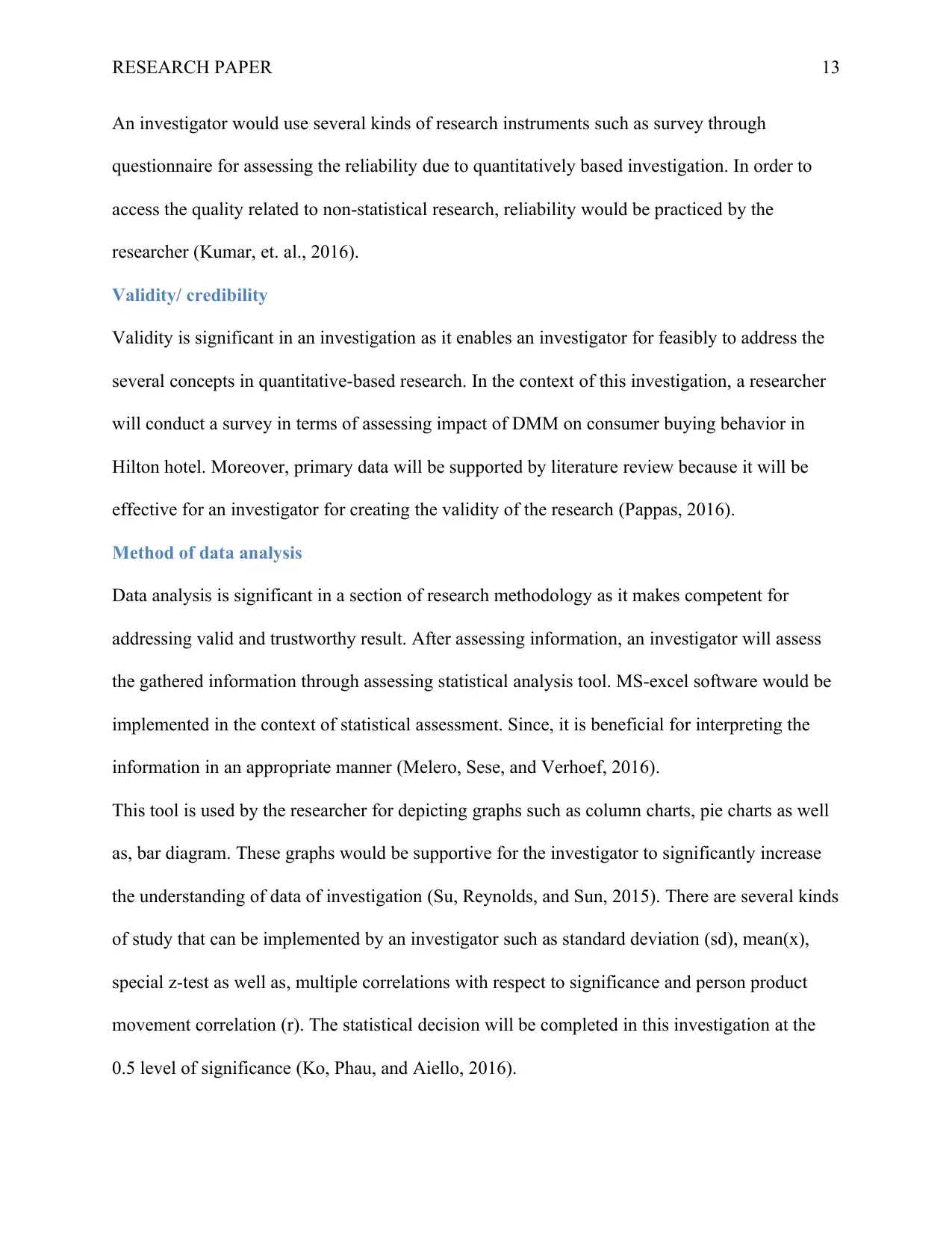
RESEARCH PAPER 13
An investigator would use several kinds of research instruments such as survey through
questionnaire for assessing the reliability due to quantitatively based investigation. In order to
access the quality related to non-statistical research, reliability would be practiced by the
researcher (Kumar, et. al., 2016).
Validity/ credibility
Validity is significant in an investigation as it enables an investigator for feasibly to address the
several concepts in quantitative-based research. In the context of this investigation, a researcher
will conduct a survey in terms of assessing impact of DMM on consumer buying behavior in
Hilton hotel. Moreover, primary data will be supported by literature review because it will be
effective for an investigator for creating the validity of the research (Pappas, 2016).
Method of data analysis
Data analysis is significant in a section of research methodology as it makes competent for
addressing valid and trustworthy result. After assessing information, an investigator will assess
the gathered information through assessing statistical analysis tool. MS-excel software would be
implemented in the context of statistical assessment. Since, it is beneficial for interpreting the
information in an appropriate manner (Melero, Sese, and Verhoef, 2016).
This tool is used by the researcher for depicting graphs such as column charts, pie charts as well
as, bar diagram. These graphs would be supportive for the investigator to significantly increase
the understanding of data of investigation (Su, Reynolds, and Sun, 2015). There are several kinds
of study that can be implemented by an investigator such as standard deviation (sd), mean(x),
special z-test as well as, multiple correlations with respect to significance and person product
movement correlation (r). The statistical decision will be completed in this investigation at the
0.5 level of significance (Ko, Phau, and Aiello, 2016).
An investigator would use several kinds of research instruments such as survey through
questionnaire for assessing the reliability due to quantitatively based investigation. In order to
access the quality related to non-statistical research, reliability would be practiced by the
researcher (Kumar, et. al., 2016).
Validity/ credibility
Validity is significant in an investigation as it enables an investigator for feasibly to address the
several concepts in quantitative-based research. In the context of this investigation, a researcher
will conduct a survey in terms of assessing impact of DMM on consumer buying behavior in
Hilton hotel. Moreover, primary data will be supported by literature review because it will be
effective for an investigator for creating the validity of the research (Pappas, 2016).
Method of data analysis
Data analysis is significant in a section of research methodology as it makes competent for
addressing valid and trustworthy result. After assessing information, an investigator will assess
the gathered information through assessing statistical analysis tool. MS-excel software would be
implemented in the context of statistical assessment. Since, it is beneficial for interpreting the
information in an appropriate manner (Melero, Sese, and Verhoef, 2016).
This tool is used by the researcher for depicting graphs such as column charts, pie charts as well
as, bar diagram. These graphs would be supportive for the investigator to significantly increase
the understanding of data of investigation (Su, Reynolds, and Sun, 2015). There are several kinds
of study that can be implemented by an investigator such as standard deviation (sd), mean(x),
special z-test as well as, multiple correlations with respect to significance and person product
movement correlation (r). The statistical decision will be completed in this investigation at the
0.5 level of significance (Ko, Phau, and Aiello, 2016).
Paraphrase This Document
Need a fresh take? Get an instant paraphrase of this document with our AI Paraphraser
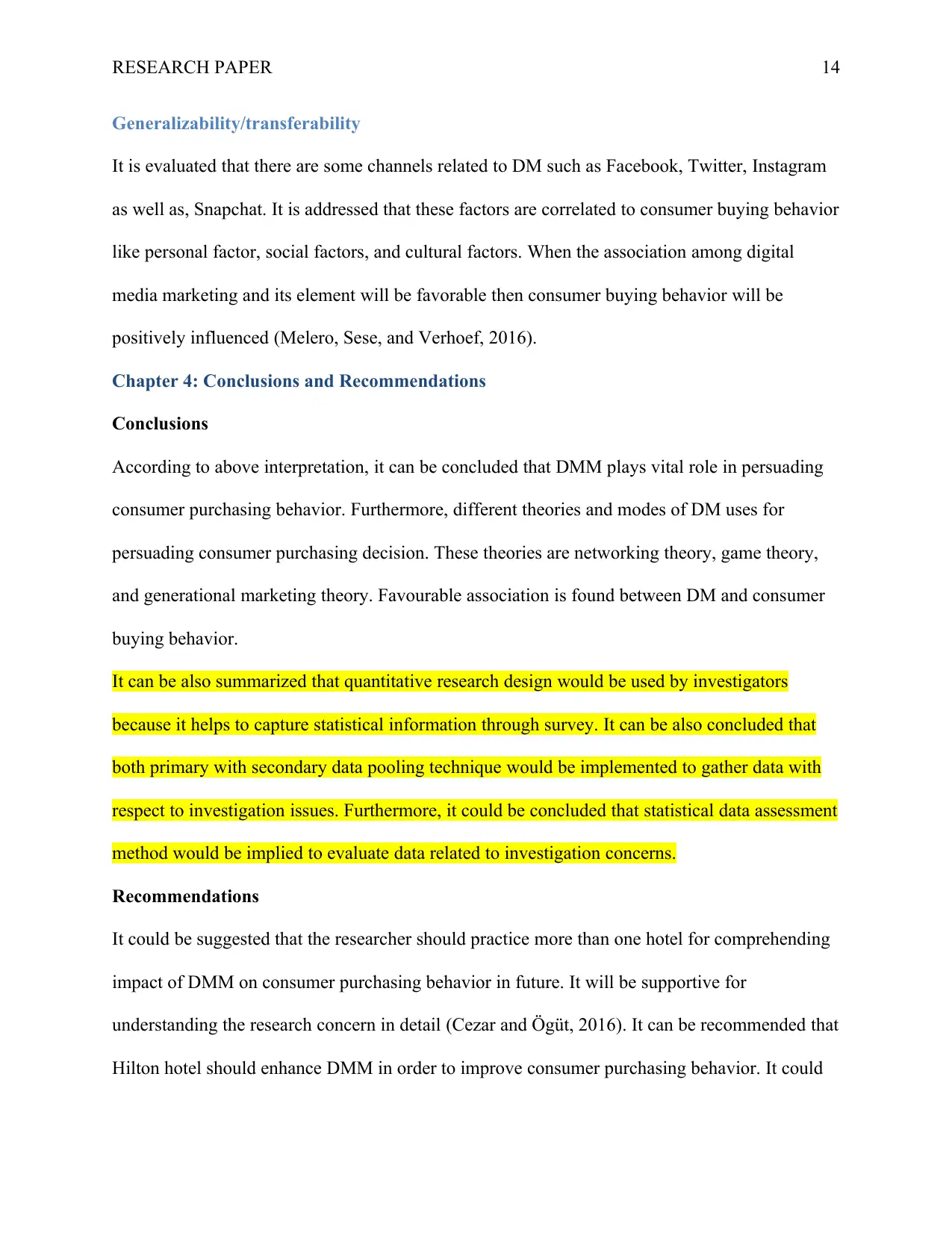
RESEARCH PAPER 14
Generalizability/transferability
It is evaluated that there are some channels related to DM such as Facebook, Twitter, Instagram
as well as, Snapchat. It is addressed that these factors are correlated to consumer buying behavior
like personal factor, social factors, and cultural factors. When the association among digital
media marketing and its element will be favorable then consumer buying behavior will be
positively influenced (Melero, Sese, and Verhoef, 2016).
Chapter 4: Conclusions and Recommendations
Conclusions
According to above interpretation, it can be concluded that DMM plays vital role in persuading
consumer purchasing behavior. Furthermore, different theories and modes of DM uses for
persuading consumer purchasing decision. These theories are networking theory, game theory,
and generational marketing theory. Favourable association is found between DM and consumer
buying behavior.
It can be also summarized that quantitative research design would be used by investigators
because it helps to capture statistical information through survey. It can be also concluded that
both primary with secondary data pooling technique would be implemented to gather data with
respect to investigation issues. Furthermore, it could be concluded that statistical data assessment
method would be implied to evaluate data related to investigation concerns.
Recommendations
It could be suggested that the researcher should practice more than one hotel for comprehending
impact of DMM on consumer purchasing behavior in future. It will be supportive for
understanding the research concern in detail (Cezar and Ögüt, 2016). It can be recommended that
Hilton hotel should enhance DMM in order to improve consumer purchasing behavior. It could
Generalizability/transferability
It is evaluated that there are some channels related to DM such as Facebook, Twitter, Instagram
as well as, Snapchat. It is addressed that these factors are correlated to consumer buying behavior
like personal factor, social factors, and cultural factors. When the association among digital
media marketing and its element will be favorable then consumer buying behavior will be
positively influenced (Melero, Sese, and Verhoef, 2016).
Chapter 4: Conclusions and Recommendations
Conclusions
According to above interpretation, it can be concluded that DMM plays vital role in persuading
consumer purchasing behavior. Furthermore, different theories and modes of DM uses for
persuading consumer purchasing decision. These theories are networking theory, game theory,
and generational marketing theory. Favourable association is found between DM and consumer
buying behavior.
It can be also summarized that quantitative research design would be used by investigators
because it helps to capture statistical information through survey. It can be also concluded that
both primary with secondary data pooling technique would be implemented to gather data with
respect to investigation issues. Furthermore, it could be concluded that statistical data assessment
method would be implied to evaluate data related to investigation concerns.
Recommendations
It could be suggested that the researcher should practice more than one hotel for comprehending
impact of DMM on consumer purchasing behavior in future. It will be supportive for
understanding the research concern in detail (Cezar and Ögüt, 2016). It can be recommended that
Hilton hotel should enhance DMM in order to improve consumer purchasing behavior. It could
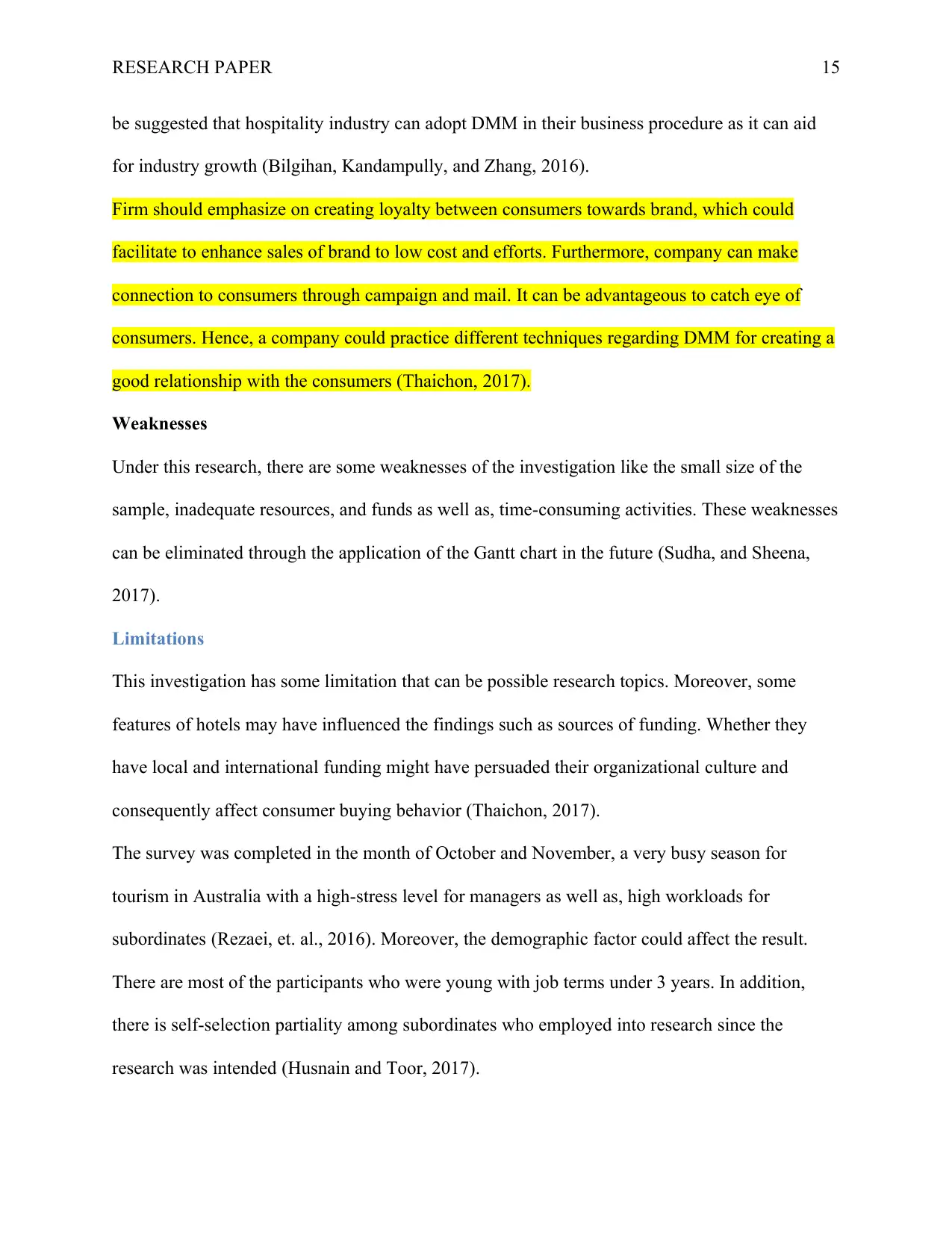
RESEARCH PAPER 15
be suggested that hospitality industry can adopt DMM in their business procedure as it can aid
for industry growth (Bilgihan, Kandampully, and Zhang, 2016).
Firm should emphasize on creating loyalty between consumers towards brand, which could
facilitate to enhance sales of brand to low cost and efforts. Furthermore, company can make
connection to consumers through campaign and mail. It can be advantageous to catch eye of
consumers. Hence, a company could practice different techniques regarding DMM for creating a
good relationship with the consumers (Thaichon, 2017).
Weaknesses
Under this research, there are some weaknesses of the investigation like the small size of the
sample, inadequate resources, and funds as well as, time-consuming activities. These weaknesses
can be eliminated through the application of the Gantt chart in the future (Sudha, and Sheena,
2017).
Limitations
This investigation has some limitation that can be possible research topics. Moreover, some
features of hotels may have influenced the findings such as sources of funding. Whether they
have local and international funding might have persuaded their organizational culture and
consequently affect consumer buying behavior (Thaichon, 2017).
The survey was completed in the month of October and November, a very busy season for
tourism in Australia with a high-stress level for managers as well as, high workloads for
subordinates (Rezaei, et. al., 2016). Moreover, the demographic factor could affect the result.
There are most of the participants who were young with job terms under 3 years. In addition,
there is self-selection partiality among subordinates who employed into research since the
research was intended (Husnain and Toor, 2017).
be suggested that hospitality industry can adopt DMM in their business procedure as it can aid
for industry growth (Bilgihan, Kandampully, and Zhang, 2016).
Firm should emphasize on creating loyalty between consumers towards brand, which could
facilitate to enhance sales of brand to low cost and efforts. Furthermore, company can make
connection to consumers through campaign and mail. It can be advantageous to catch eye of
consumers. Hence, a company could practice different techniques regarding DMM for creating a
good relationship with the consumers (Thaichon, 2017).
Weaknesses
Under this research, there are some weaknesses of the investigation like the small size of the
sample, inadequate resources, and funds as well as, time-consuming activities. These weaknesses
can be eliminated through the application of the Gantt chart in the future (Sudha, and Sheena,
2017).
Limitations
This investigation has some limitation that can be possible research topics. Moreover, some
features of hotels may have influenced the findings such as sources of funding. Whether they
have local and international funding might have persuaded their organizational culture and
consequently affect consumer buying behavior (Thaichon, 2017).
The survey was completed in the month of October and November, a very busy season for
tourism in Australia with a high-stress level for managers as well as, high workloads for
subordinates (Rezaei, et. al., 2016). Moreover, the demographic factor could affect the result.
There are most of the participants who were young with job terms under 3 years. In addition,
there is self-selection partiality among subordinates who employed into research since the
research was intended (Husnain and Toor, 2017).
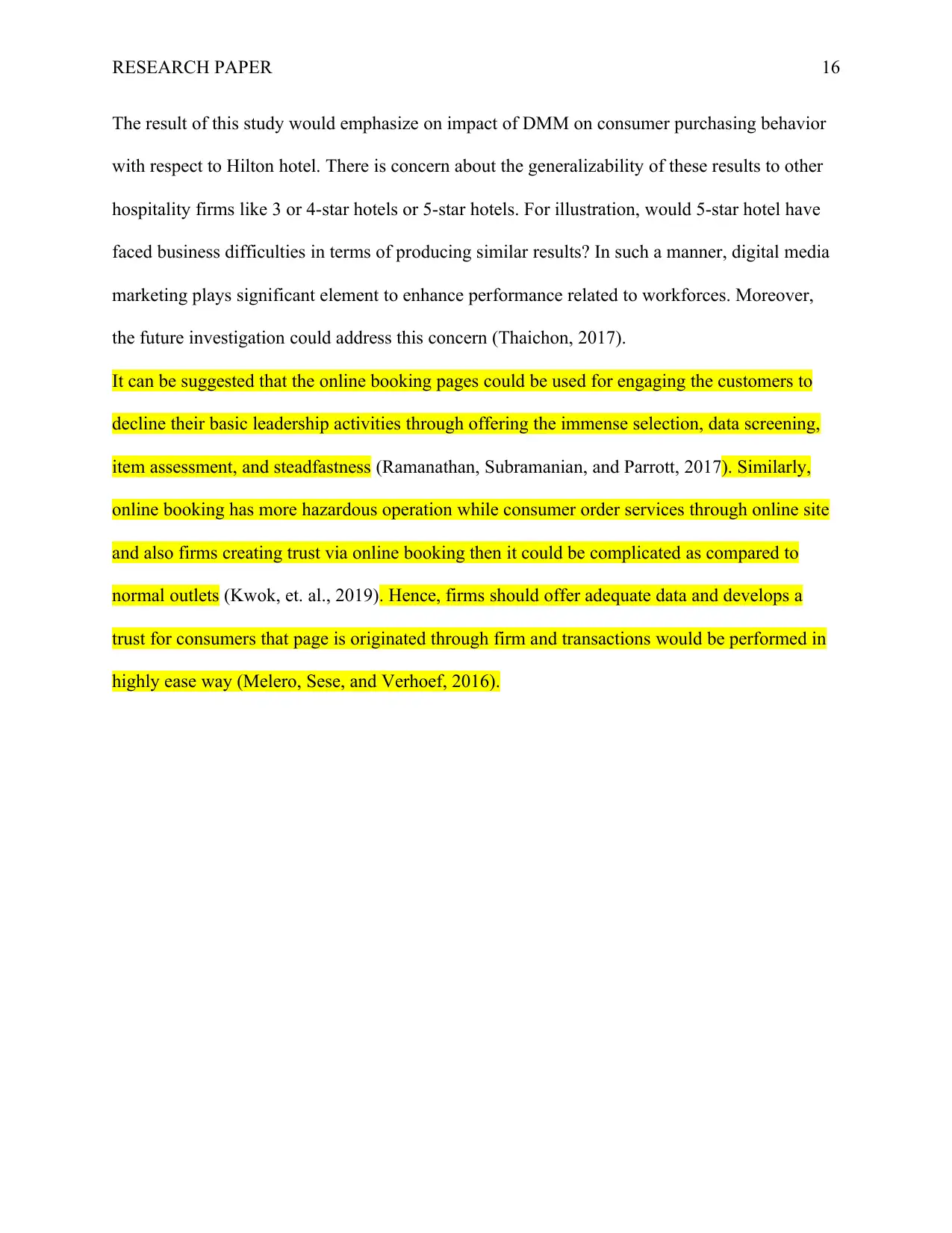
RESEARCH PAPER 16
The result of this study would emphasize on impact of DMM on consumer purchasing behavior
with respect to Hilton hotel. There is concern about the generalizability of these results to other
hospitality firms like 3 or 4-star hotels or 5-star hotels. For illustration, would 5-star hotel have
faced business difficulties in terms of producing similar results? In such a manner, digital media
marketing plays significant element to enhance performance related to workforces. Moreover,
the future investigation could address this concern (Thaichon, 2017).
It can be suggested that the online booking pages could be used for engaging the customers to
decline their basic leadership activities through offering the immense selection, data screening,
item assessment, and steadfastness (Ramanathan, Subramanian, and Parrott, 2017). Similarly,
online booking has more hazardous operation while consumer order services through online site
and also firms creating trust via online booking then it could be complicated as compared to
normal outlets (Kwok, et. al., 2019). Hence, firms should offer adequate data and develops a
trust for consumers that page is originated through firm and transactions would be performed in
highly ease way (Melero, Sese, and Verhoef, 2016).
The result of this study would emphasize on impact of DMM on consumer purchasing behavior
with respect to Hilton hotel. There is concern about the generalizability of these results to other
hospitality firms like 3 or 4-star hotels or 5-star hotels. For illustration, would 5-star hotel have
faced business difficulties in terms of producing similar results? In such a manner, digital media
marketing plays significant element to enhance performance related to workforces. Moreover,
the future investigation could address this concern (Thaichon, 2017).
It can be suggested that the online booking pages could be used for engaging the customers to
decline their basic leadership activities through offering the immense selection, data screening,
item assessment, and steadfastness (Ramanathan, Subramanian, and Parrott, 2017). Similarly,
online booking has more hazardous operation while consumer order services through online site
and also firms creating trust via online booking then it could be complicated as compared to
normal outlets (Kwok, et. al., 2019). Hence, firms should offer adequate data and develops a
trust for consumers that page is originated through firm and transactions would be performed in
highly ease way (Melero, Sese, and Verhoef, 2016).
Secure Best Marks with AI Grader
Need help grading? Try our AI Grader for instant feedback on your assignments.
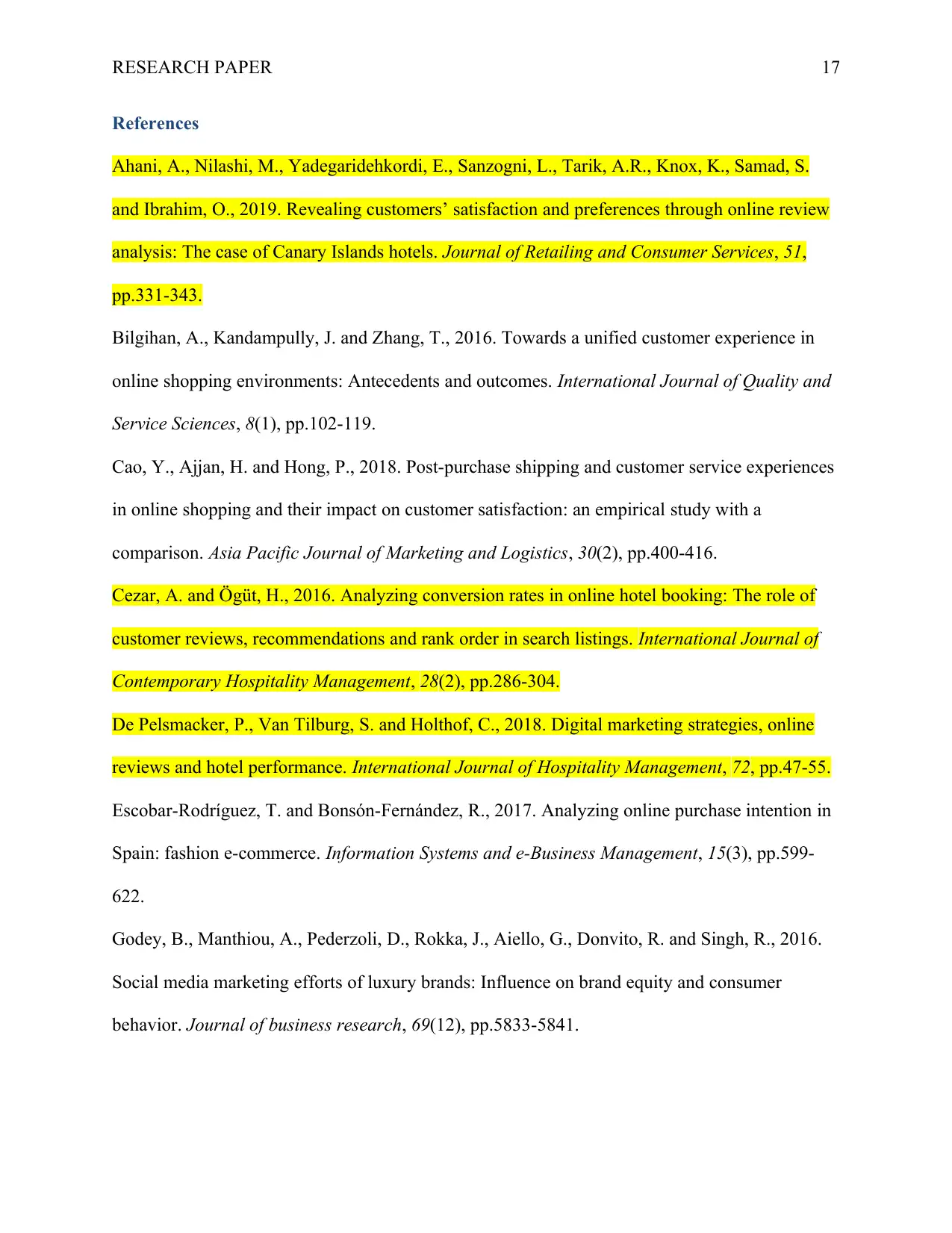
RESEARCH PAPER 17
References
Ahani, A., Nilashi, M., Yadegaridehkordi, E., Sanzogni, L., Tarik, A.R., Knox, K., Samad, S.
and Ibrahim, O., 2019. Revealing customers’ satisfaction and preferences through online review
analysis: The case of Canary Islands hotels. Journal of Retailing and Consumer Services, 51,
pp.331-343.
Bilgihan, A., Kandampully, J. and Zhang, T., 2016. Towards a unified customer experience in
online shopping environments: Antecedents and outcomes. International Journal of Quality and
Service Sciences, 8(1), pp.102-119.
Cao, Y., Ajjan, H. and Hong, P., 2018. Post-purchase shipping and customer service experiences
in online shopping and their impact on customer satisfaction: an empirical study with a
comparison. Asia Pacific Journal of Marketing and Logistics, 30(2), pp.400-416.
Cezar, A. and Ögüt, H., 2016. Analyzing conversion rates in online hotel booking: The role of
customer reviews, recommendations and rank order in search listings. International Journal of
Contemporary Hospitality Management, 28(2), pp.286-304.
De Pelsmacker, P., Van Tilburg, S. and Holthof, C., 2018. Digital marketing strategies, online
reviews and hotel performance. International Journal of Hospitality Management, 72, pp.47-55.
Escobar-Rodríguez, T. and Bonsón-Fernández, R., 2017. Analyzing online purchase intention in
Spain: fashion e-commerce. Information Systems and e-Business Management, 15(3), pp.599-
622.
Godey, B., Manthiou, A., Pederzoli, D., Rokka, J., Aiello, G., Donvito, R. and Singh, R., 2016.
Social media marketing efforts of luxury brands: Influence on brand equity and consumer
behavior. Journal of business research, 69(12), pp.5833-5841.
References
Ahani, A., Nilashi, M., Yadegaridehkordi, E., Sanzogni, L., Tarik, A.R., Knox, K., Samad, S.
and Ibrahim, O., 2019. Revealing customers’ satisfaction and preferences through online review
analysis: The case of Canary Islands hotels. Journal of Retailing and Consumer Services, 51,
pp.331-343.
Bilgihan, A., Kandampully, J. and Zhang, T., 2016. Towards a unified customer experience in
online shopping environments: Antecedents and outcomes. International Journal of Quality and
Service Sciences, 8(1), pp.102-119.
Cao, Y., Ajjan, H. and Hong, P., 2018. Post-purchase shipping and customer service experiences
in online shopping and their impact on customer satisfaction: an empirical study with a
comparison. Asia Pacific Journal of Marketing and Logistics, 30(2), pp.400-416.
Cezar, A. and Ögüt, H., 2016. Analyzing conversion rates in online hotel booking: The role of
customer reviews, recommendations and rank order in search listings. International Journal of
Contemporary Hospitality Management, 28(2), pp.286-304.
De Pelsmacker, P., Van Tilburg, S. and Holthof, C., 2018. Digital marketing strategies, online
reviews and hotel performance. International Journal of Hospitality Management, 72, pp.47-55.
Escobar-Rodríguez, T. and Bonsón-Fernández, R., 2017. Analyzing online purchase intention in
Spain: fashion e-commerce. Information Systems and e-Business Management, 15(3), pp.599-
622.
Godey, B., Manthiou, A., Pederzoli, D., Rokka, J., Aiello, G., Donvito, R. and Singh, R., 2016.
Social media marketing efforts of luxury brands: Influence on brand equity and consumer
behavior. Journal of business research, 69(12), pp.5833-5841.
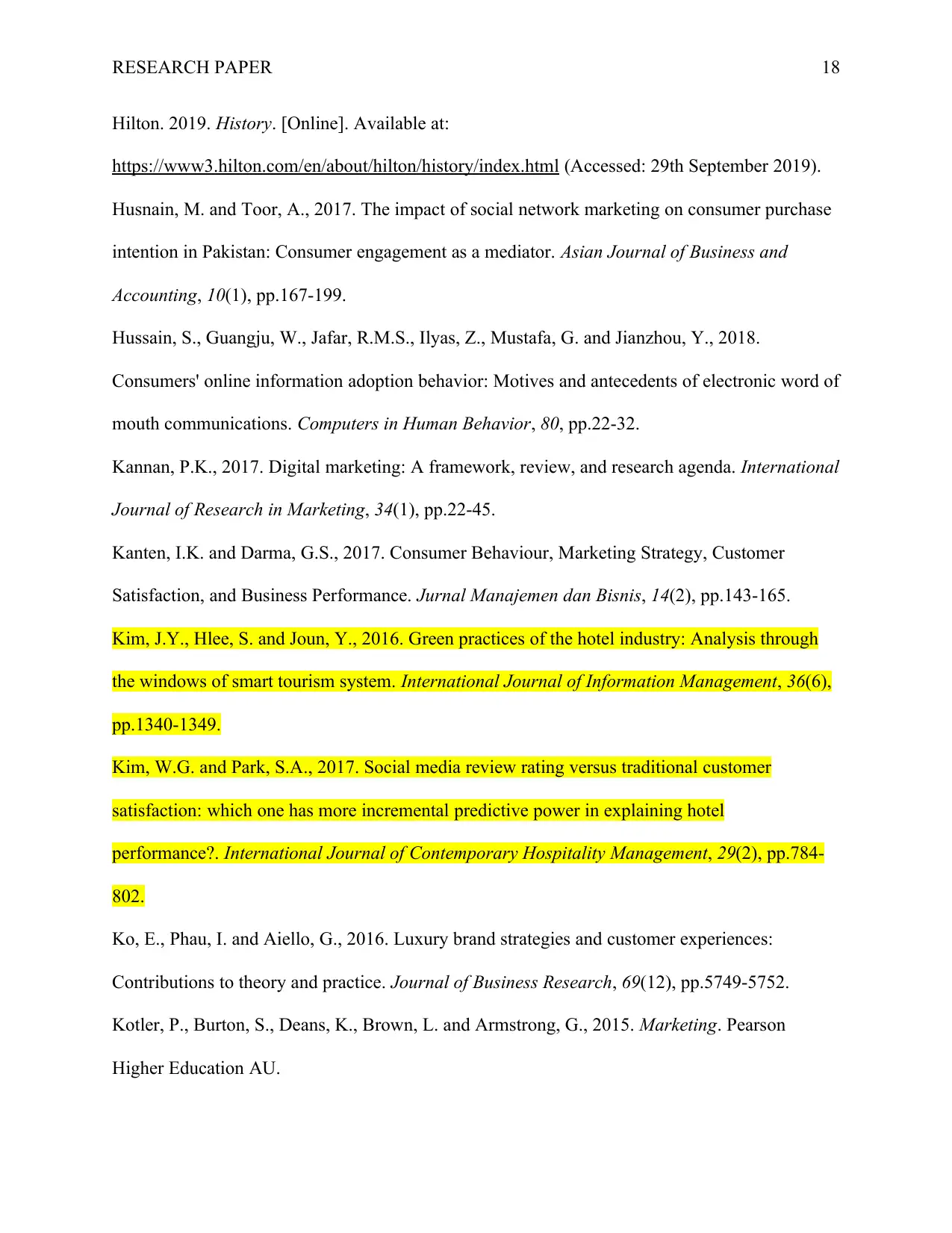
RESEARCH PAPER 18
Hilton. 2019. History. [Online]. Available at:
https://www3.hilton.com/en/about/hilton/history/index.html (Accessed: 29th September 2019).
Husnain, M. and Toor, A., 2017. The impact of social network marketing on consumer purchase
intention in Pakistan: Consumer engagement as a mediator. Asian Journal of Business and
Accounting, 10(1), pp.167-199.
Hussain, S., Guangju, W., Jafar, R.M.S., Ilyas, Z., Mustafa, G. and Jianzhou, Y., 2018.
Consumers' online information adoption behavior: Motives and antecedents of electronic word of
mouth communications. Computers in Human Behavior, 80, pp.22-32.
Kannan, P.K., 2017. Digital marketing: A framework, review, and research agenda. International
Journal of Research in Marketing, 34(1), pp.22-45.
Kanten, I.K. and Darma, G.S., 2017. Consumer Behaviour, Marketing Strategy, Customer
Satisfaction, and Business Performance. Jurnal Manajemen dan Bisnis, 14(2), pp.143-165.
Kim, J.Y., Hlee, S. and Joun, Y., 2016. Green practices of the hotel industry: Analysis through
the windows of smart tourism system. International Journal of Information Management, 36(6),
pp.1340-1349.
Kim, W.G. and Park, S.A., 2017. Social media review rating versus traditional customer
satisfaction: which one has more incremental predictive power in explaining hotel
performance?. International Journal of Contemporary Hospitality Management, 29(2), pp.784-
802.
Ko, E., Phau, I. and Aiello, G., 2016. Luxury brand strategies and customer experiences:
Contributions to theory and practice. Journal of Business Research, 69(12), pp.5749-5752.
Kotler, P., Burton, S., Deans, K., Brown, L. and Armstrong, G., 2015. Marketing. Pearson
Higher Education AU.
Hilton. 2019. History. [Online]. Available at:
https://www3.hilton.com/en/about/hilton/history/index.html (Accessed: 29th September 2019).
Husnain, M. and Toor, A., 2017. The impact of social network marketing on consumer purchase
intention in Pakistan: Consumer engagement as a mediator. Asian Journal of Business and
Accounting, 10(1), pp.167-199.
Hussain, S., Guangju, W., Jafar, R.M.S., Ilyas, Z., Mustafa, G. and Jianzhou, Y., 2018.
Consumers' online information adoption behavior: Motives and antecedents of electronic word of
mouth communications. Computers in Human Behavior, 80, pp.22-32.
Kannan, P.K., 2017. Digital marketing: A framework, review, and research agenda. International
Journal of Research in Marketing, 34(1), pp.22-45.
Kanten, I.K. and Darma, G.S., 2017. Consumer Behaviour, Marketing Strategy, Customer
Satisfaction, and Business Performance. Jurnal Manajemen dan Bisnis, 14(2), pp.143-165.
Kim, J.Y., Hlee, S. and Joun, Y., 2016. Green practices of the hotel industry: Analysis through
the windows of smart tourism system. International Journal of Information Management, 36(6),
pp.1340-1349.
Kim, W.G. and Park, S.A., 2017. Social media review rating versus traditional customer
satisfaction: which one has more incremental predictive power in explaining hotel
performance?. International Journal of Contemporary Hospitality Management, 29(2), pp.784-
802.
Ko, E., Phau, I. and Aiello, G., 2016. Luxury brand strategies and customer experiences:
Contributions to theory and practice. Journal of Business Research, 69(12), pp.5749-5752.
Kotler, P., Burton, S., Deans, K., Brown, L. and Armstrong, G., 2015. Marketing. Pearson
Higher Education AU.
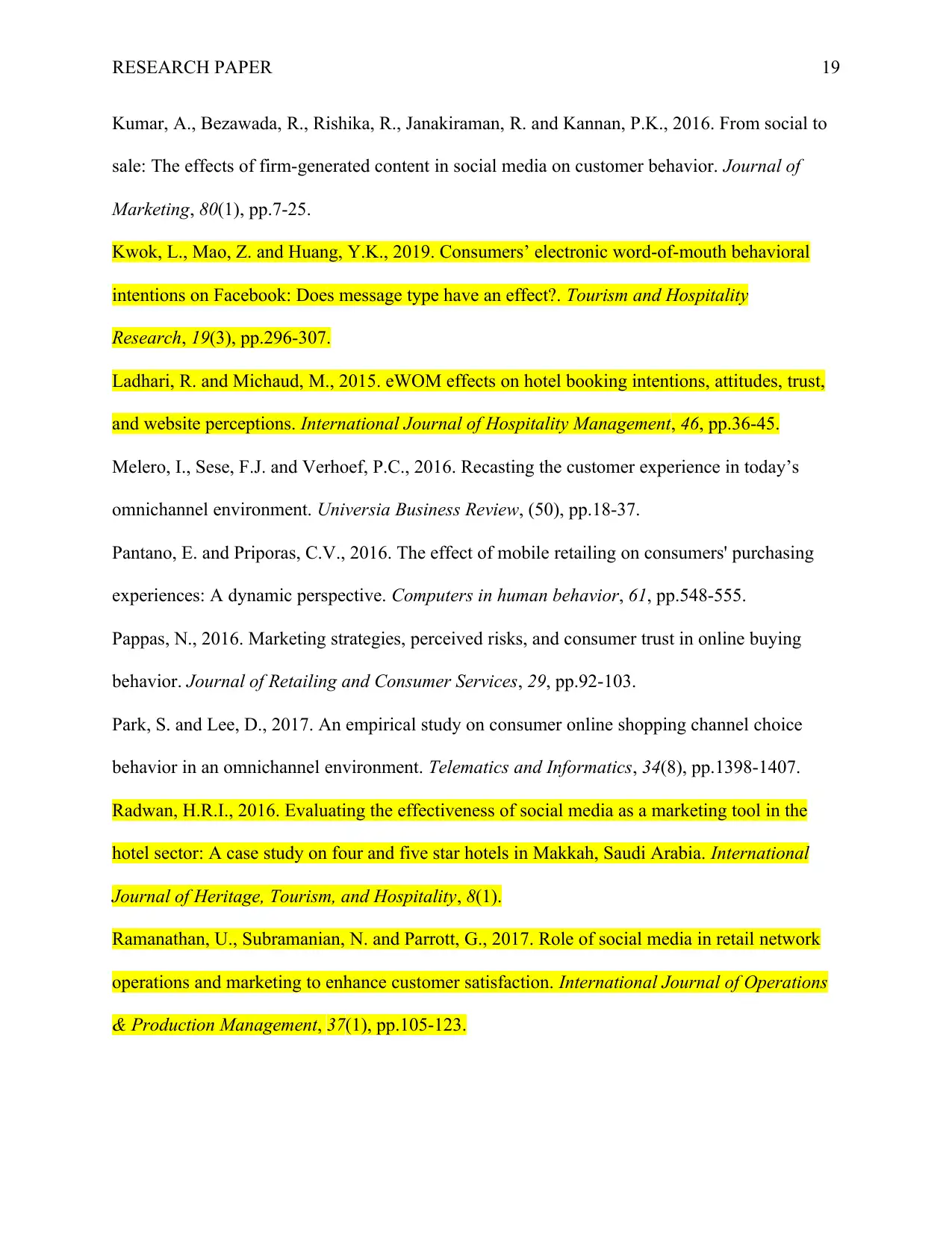
RESEARCH PAPER 19
Kumar, A., Bezawada, R., Rishika, R., Janakiraman, R. and Kannan, P.K., 2016. From social to
sale: The effects of firm-generated content in social media on customer behavior. Journal of
Marketing, 80(1), pp.7-25.
Kwok, L., Mao, Z. and Huang, Y.K., 2019. Consumers’ electronic word-of-mouth behavioral
intentions on Facebook: Does message type have an effect?. Tourism and Hospitality
Research, 19(3), pp.296-307.
Ladhari, R. and Michaud, M., 2015. eWOM effects on hotel booking intentions, attitudes, trust,
and website perceptions. International Journal of Hospitality Management, 46, pp.36-45.
Melero, I., Sese, F.J. and Verhoef, P.C., 2016. Recasting the customer experience in today’s
omnichannel environment. Universia Business Review, (50), pp.18-37.
Pantano, E. and Priporas, C.V., 2016. The effect of mobile retailing on consumers' purchasing
experiences: A dynamic perspective. Computers in human behavior, 61, pp.548-555.
Pappas, N., 2016. Marketing strategies, perceived risks, and consumer trust in online buying
behavior. Journal of Retailing and Consumer Services, 29, pp.92-103.
Park, S. and Lee, D., 2017. An empirical study on consumer online shopping channel choice
behavior in an omnichannel environment. Telematics and Informatics, 34(8), pp.1398-1407.
Radwan, H.R.I., 2016. Evaluating the effectiveness of social media as a marketing tool in the
hotel sector: A case study on four and five star hotels in Makkah, Saudi Arabia. International
Journal of Heritage, Tourism, and Hospitality, 8(1).
Ramanathan, U., Subramanian, N. and Parrott, G., 2017. Role of social media in retail network
operations and marketing to enhance customer satisfaction. International Journal of Operations
& Production Management, 37(1), pp.105-123.
Kumar, A., Bezawada, R., Rishika, R., Janakiraman, R. and Kannan, P.K., 2016. From social to
sale: The effects of firm-generated content in social media on customer behavior. Journal of
Marketing, 80(1), pp.7-25.
Kwok, L., Mao, Z. and Huang, Y.K., 2019. Consumers’ electronic word-of-mouth behavioral
intentions on Facebook: Does message type have an effect?. Tourism and Hospitality
Research, 19(3), pp.296-307.
Ladhari, R. and Michaud, M., 2015. eWOM effects on hotel booking intentions, attitudes, trust,
and website perceptions. International Journal of Hospitality Management, 46, pp.36-45.
Melero, I., Sese, F.J. and Verhoef, P.C., 2016. Recasting the customer experience in today’s
omnichannel environment. Universia Business Review, (50), pp.18-37.
Pantano, E. and Priporas, C.V., 2016. The effect of mobile retailing on consumers' purchasing
experiences: A dynamic perspective. Computers in human behavior, 61, pp.548-555.
Pappas, N., 2016. Marketing strategies, perceived risks, and consumer trust in online buying
behavior. Journal of Retailing and Consumer Services, 29, pp.92-103.
Park, S. and Lee, D., 2017. An empirical study on consumer online shopping channel choice
behavior in an omnichannel environment. Telematics and Informatics, 34(8), pp.1398-1407.
Radwan, H.R.I., 2016. Evaluating the effectiveness of social media as a marketing tool in the
hotel sector: A case study on four and five star hotels in Makkah, Saudi Arabia. International
Journal of Heritage, Tourism, and Hospitality, 8(1).
Ramanathan, U., Subramanian, N. and Parrott, G., 2017. Role of social media in retail network
operations and marketing to enhance customer satisfaction. International Journal of Operations
& Production Management, 37(1), pp.105-123.
Paraphrase This Document
Need a fresh take? Get an instant paraphrase of this document with our AI Paraphraser
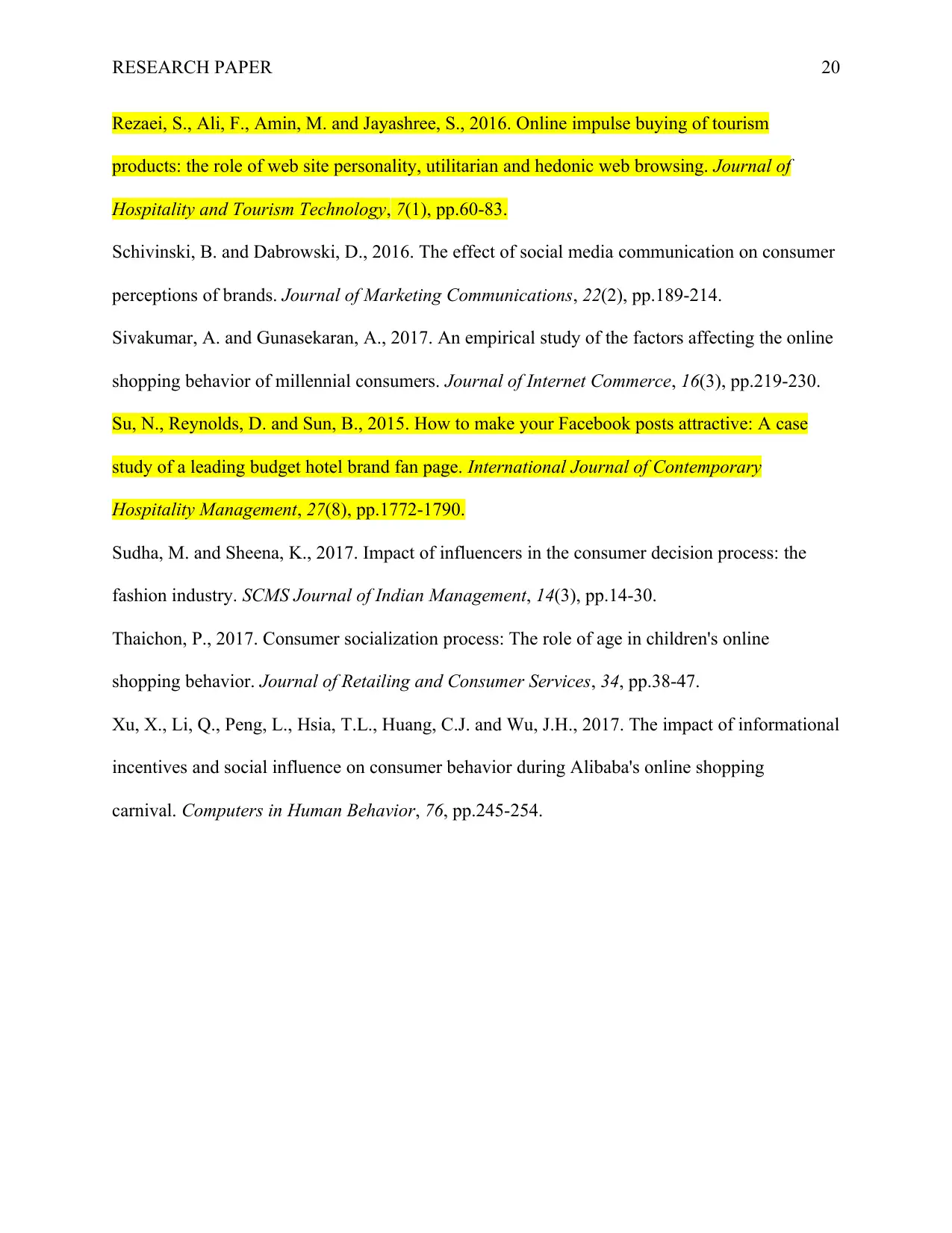
RESEARCH PAPER 20
Rezaei, S., Ali, F., Amin, M. and Jayashree, S., 2016. Online impulse buying of tourism
products: the role of web site personality, utilitarian and hedonic web browsing. Journal of
Hospitality and Tourism Technology, 7(1), pp.60-83.
Schivinski, B. and Dabrowski, D., 2016. The effect of social media communication on consumer
perceptions of brands. Journal of Marketing Communications, 22(2), pp.189-214.
Sivakumar, A. and Gunasekaran, A., 2017. An empirical study of the factors affecting the online
shopping behavior of millennial consumers. Journal of Internet Commerce, 16(3), pp.219-230.
Su, N., Reynolds, D. and Sun, B., 2015. How to make your Facebook posts attractive: A case
study of a leading budget hotel brand fan page. International Journal of Contemporary
Hospitality Management, 27(8), pp.1772-1790.
Sudha, M. and Sheena, K., 2017. Impact of influencers in the consumer decision process: the
fashion industry. SCMS Journal of Indian Management, 14(3), pp.14-30.
Thaichon, P., 2017. Consumer socialization process: The role of age in children's online
shopping behavior. Journal of Retailing and Consumer Services, 34, pp.38-47.
Xu, X., Li, Q., Peng, L., Hsia, T.L., Huang, C.J. and Wu, J.H., 2017. The impact of informational
incentives and social influence on consumer behavior during Alibaba's online shopping
carnival. Computers in Human Behavior, 76, pp.245-254.
Rezaei, S., Ali, F., Amin, M. and Jayashree, S., 2016. Online impulse buying of tourism
products: the role of web site personality, utilitarian and hedonic web browsing. Journal of
Hospitality and Tourism Technology, 7(1), pp.60-83.
Schivinski, B. and Dabrowski, D., 2016. The effect of social media communication on consumer
perceptions of brands. Journal of Marketing Communications, 22(2), pp.189-214.
Sivakumar, A. and Gunasekaran, A., 2017. An empirical study of the factors affecting the online
shopping behavior of millennial consumers. Journal of Internet Commerce, 16(3), pp.219-230.
Su, N., Reynolds, D. and Sun, B., 2015. How to make your Facebook posts attractive: A case
study of a leading budget hotel brand fan page. International Journal of Contemporary
Hospitality Management, 27(8), pp.1772-1790.
Sudha, M. and Sheena, K., 2017. Impact of influencers in the consumer decision process: the
fashion industry. SCMS Journal of Indian Management, 14(3), pp.14-30.
Thaichon, P., 2017. Consumer socialization process: The role of age in children's online
shopping behavior. Journal of Retailing and Consumer Services, 34, pp.38-47.
Xu, X., Li, Q., Peng, L., Hsia, T.L., Huang, C.J. and Wu, J.H., 2017. The impact of informational
incentives and social influence on consumer behavior during Alibaba's online shopping
carnival. Computers in Human Behavior, 76, pp.245-254.
1 out of 20
Your All-in-One AI-Powered Toolkit for Academic Success.
+13062052269
info@desklib.com
Available 24*7 on WhatsApp / Email
![[object Object]](/_next/static/media/star-bottom.7253800d.svg)
Unlock your academic potential
© 2024 | Zucol Services PVT LTD | All rights reserved.





